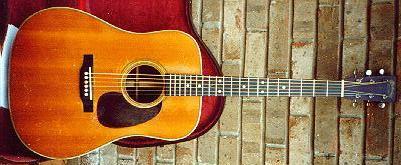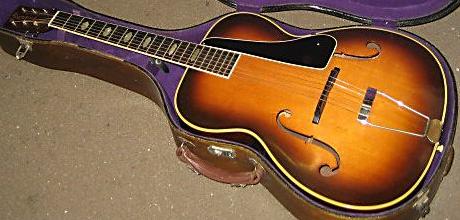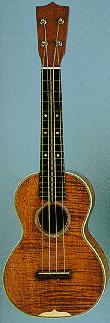Vintage Guitars Info's
Vintage Martin Guitars and Ukes
Vintage Guitar Info.
Collecting vintage Martin guitars and ukes. General specifications, serial numbers, model information. Private vintage guitar collector.
Contact the vintage guitar info guy.
Torch peghead inlay and
"snowflake" fingerboard
inlays as used on 1914 to
1938 style 45 Martins.

- "What Type of Martin do I Have?"
- Introduction and Collectibility
- Other Brands made by Martin
- Serial Numbers (How to Find the Year)
- Body Size Designations
- Flat Top Production Years by Model
- General Specs and Information
- Martin Playability (Neck Sets and Bridges)
- Picture Gallery, Martin section
Martin Flat Top Model Info:
Martin Arch Top Model Info:
Martin Ukulele Model Info:
"What Type of Martin Do I have?"
-
Before much can be determined about a Martin guitar,
several things must be identified:
- The year it was made (using the serial number, which exists on all Martins 1898 and later).
- The type of guitar (flattop, archtop, uke, etc).
- The body size (for flattop guitars generally O, OO, OOO, OM, D, etc.)
- The body style (for flattop guitars generally 15, 16, 17, 18, 21, 28, etc.)
- Oringinality (have any of the parts, such as the bridge or tuners, been changed or modified?)
- How does it play?
First Determine the Year.
On Martin guitars, this is pretty easy. Every Martin guitar made in 1898 and later,
there is a serial number inside the guitar. This number can be used to determine the
exact year of manufacture. See the serial number section below for details.
Tenor guitar (4 strings).
Note the nicely grained
mahogany top. Tenor guitar
are not very collectible
though, as they were sold
from the 1930s to the 1950s
mostly to transition banjo
players to guitar!
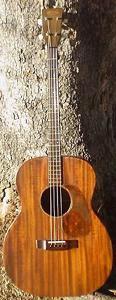
-
Next Determine the Type of Guitar.
- 4 Strings: a ukulele or tenor guitar.
- 10 Strings: Tiple.
- Uke size with 8 strings: Taropatch
- 8 strings (not a Uke): Mandolin.
- Archtop: an arched top to the guitar with either a round soundhole, or two "f" holes on either side of the body. Trapeze style bridge. Made only during the 1930s.
- Flattop: a flat top to the guitar, and a single round sound hole under the strings. Pin style bridge.
Most Martin guitars made are "flat top" models. That is, they have a round sound hole in approximately the center of the flat top of the guitar, with a "pin" style bridge. Martin also made some archtop models during the 1930s. These can have a round sound hole, or two "f" style sound holes (one on each side of the top of the body), and have an arched top, with a "trapeze" style bridge. Martin also made ukuleles. If a guitar only has four strings (and is not a ukulele), this is known as a Tenor guitar. Uke size instruments with ten string are Tiples. Uke size instruments with eight strings are Taropatches. Martin also made mandolins, which have eight strings. To summarize:
-
Flat Top Guitar Body Size.
Martin flat top guitars were made in various sizes. The bigger the guitar body, the better and more collectible the guitar. This is why guitar body size is so important to identify on a Martin flat top guitar. Starting in October 1930, Martin stamped the guitar body size right above the serial number inside the guitar. This makes identifying body size on October 1930 and later guitar very easy. For flat top guitars made before October 1930, the easiest way to figure out the body size is to use the flat top guitar body size chart below. Body sizes, pretty much from smallest to biggest, include O, OO, OOO, OM, D.
Martin Instrument Styles.
Nearly all Martin instruments come in different styles. The higher the style number,
the more fancy (and collectible) the instrument. Again starting in October 1930, Martin
stamped all flat top guitars with the style number, directly after the body size (and
above the serial number). Style numbers can range from 15 to 45. A letter can follow
the style number too, giving some additional info about the instrument. For example,
a "T" after the style number indicates a Tenor guitar. See the general specs
section for a full list of these suffixes.
Determine the Originality.
Originality of an instrument is very important. Modifications (any modifications),
are a bad thing in the eyes of a collector. This will greatly influence
value. Modifications can often be determined by looking at the model
specs for a particular year guitar in this web page, and compare to your instrument.
On flat top martins, the most common modifications are a replaced bridge, replaced
tuners, or replaced frets.
Finally, How does the Instrument Play?
On Martin guitars, this is a really big deal. Martins all seem to have a problem
with the "neck set" on many of their guitars before 1970. High string action is
the result, making the guitar very difficult to play. This can only be fixed
correctly by a "neck set" (removing the neck on the guitar, and refitting the
neck at a slightly increased angle, which lowers the string action). If done
correctly, this does not affect
the value of the guitar (and in fact can make it more valuable, as the guitar
is much more playable). Generally speaking, most players would agree if the
"string action" is more than 3/16 inch (5 mm) at the 12th fret,
the guitar needs a neck set. This measurement
is taken from the bottom of the low-E string, to the top of the 12th fret.
Regarding truss rods, all vintage Martin instruments post-1934 have *non-adustable* truss rods (T rod). This means the neck better be straight, otherwise an expensive repair will be in order. To check neck straightness on a guitar, first tune the guitar to pitch. Then hold the low-E string down at the 1st and 14th frets. Note the distance between the bottom of the low-E string, and the 7th fret. You should be able to put a medium guitar pick in this space. Any more, and the neck is "bowed". Any less, and the neck is "back bowed". Repeat this with the high-E string (the same results should be seen; if not, the neck has a "twist" to it).
Back to Table of Contents
Introduction and Collectibility.
-
Martin has been making some of the best flat top acoustic guitars since the
mid 1800's. Martin's other lines of instruments (electrics, archtops,
mandolins) is not nearly as desirable or collectible as their flat top
models. Because of this, any models other than flat tops (such as Martin's
archtops and electrics) are not very collectible.
Brazilian rosewood on a 1965 D-28. Note the rich
color and wavey figuring which is typical of
Brazilian rosewood. Indian rosewood, as used
from late 1969 and later, is much paler in color;
not nearly as rich looking. Indian rosewood is also
very straight grained, without the figuring and
waveyness of Brazilian rosewood. Acoustically, they
sound nearly the same.
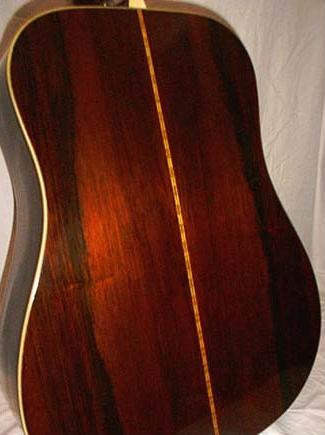
Flat top Martins from the 1840's to the 1920's represent the earliest generation of the modern flat top design. They have great workmanship, but small bodies designed for gut strings only. Because of this, these models have limited appeal and hence are less collectible than steel string models.
Twelve and fourteen fret steel string models from the mid 1920's to 1944 are the most collectible of all Martin instruments. They have excellent craftsmenship, sound, and playability, and these model are of great interest to collectors and players. Some musicians prefer the sound and feel of 12 fret models, and these are close in value to 14 fret models of the same size and period. The larger size 14 fret 000 and "D" sizes from the 1930's are considered by most collectors and musicians to represent the golden era of the flat top Martin. Note war-time models (1941 to 1944) aren't quite as desirable as the 1930's models. Lack of materials, manpower, and general social uncertainty during the war contributed to this.
-
Flat tops from 1945 to 1969 are considered good quality and have good
sound, although they are not as collectible as the 1920's to 1944
steel string models. This is largely due to the change in bracing and
materials Martin started using in 1945. Rosewood models of Brazilian
rosewood are most collectible from this era. This is because
Brazilian rosewood was basically unavailable since 1970 due to export
problems. Because of this, these models are considered more collectible.
Martin D-35 from the 1970's.
Note the Indian rosewood's color
is much lighter and not as rich
as Brazilian rosewood. Also the
grain is much straighter and boring.
This three piece back was used on
D-35's to allow Martin to use
narrower rosewood that would
otherwise go to waste.
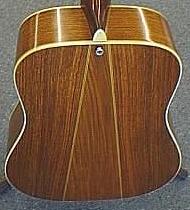
-
Flat tops from 1970 to present are considered to be excellent utility
instruments, but are not collectible. Staring in 1976, Martin
has been undergoing many changes with numerous reissues, new models,
limited editions, etc. Workmanship has improved greatly from the early
1970's, and Martin is now producing some of its best guitars in over 20
years. While not currently collector's items, these intruments have
excellent workmanship, sound, and playability.
Classical guitars by Martin are equal in craftsmenship to their steel string models. But unfortunately, their sound and feel is not what classical players seem to want. Therefore they do not have the collectability of the steel string models. I group Martin classical models to include the "NY" series and gut string models made from the 1930's and later.
because of the open peghead style, no fingerboard
inlays, and bracing for gut (nylon) strings only.
The Style 21 model is a combination of the
Style 18 and Style 28 models: The body uses
rosewood (like a 28), and a style 18 neck
(with no "ice cream cone"). This particular
model has nice Brazilian rosewood. The back of
the (style 18 like) neck can clearly been seen
with no "ice cream cone" volute.
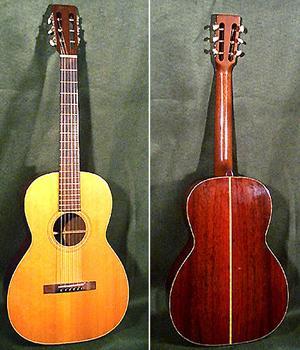
-
Acoustic archtop by Martin, again, have craftsmenship that matches
their flat top instruments. But as with classical model, Martin archtops
do not have the look, feel, or sound of traditional archtop models as
defined by Gibson or Epiphone. They may be quite rare, but they are not
collectible, especially compared to Martin flat tops.
Ukuleles by Martin are considered amoung the best ukes made. Though ukes in general aren't particularly valuable, Martin ukes are worth more than most other makes.
Tenor guitars (4 strings) by Martin have little to no collectibility. Tenor guitars were marketed as a way to get banjo players in the 1930s to the 1950s to convert to guitar. There is very little need for this today, hence these four string guitars have little value.
Electric guitars by Martin (any variety: flat top, archtop, solid body) are not sought after and have little to no value.
Back to Table of Contents
Other Brands Made by Martin.
Since 1900, Martin did make guitars, mandolins and ukes for other brands and guitar studios. No, this was not "common". Just because your guitar looks like a Martin, doesn't mean it is. Even if your instrument is one of the brands listed below, that does NOT mean it was necessarily made by Martin either! Just keep that in mind.- Bacon: a few made for Bacon Banjos in 1924.
- Belltone: fifteen guitars, ten mandolins and twelve Style 3k ukes were made for Belltone.
- Bitting Special: Martin made some mandolins for this Bethlehem, PA teacher in 1916 to 1919.
- Ditson: in 1917 to 1919, and 1923 to 1930, Martin made some guitars for the Ditson company in Boston. Early models only have a "Ditson" stamp, later models have both the "Ditson" and "Martin" stamps. The 1923 to 1930 models have Martin serial numbers. Prior to this, 483 guitars of the original 1917 to 1919 series have been documented.
- Foden: In 1912 to 1917, Martin made guitars for concert guitarist William Foden. These are similar to the standard Martin models, but have simple soundhole rings and a 20 fret fingerboard (instead of 19). Made in sizes 0 and 00, the styles were similar to Martin's Style 18, 21, 28, and a pearl trim model. Only 27 of these guitars have been documented to date.
- Jenkins: Martin made Style 1 and 2 ukes for this Kansas City mail order company.
- Olcott-Bickford: 32 guitars made for this guitarist.
- Paramount: Around 1930 Martin made about 36 guitars with strange construction. A style 2 size body mounted into a larger rim and back of rosewood, small round soundholes around a "lip" that joins the outer rims to the inner rims, no soundhole in the top, 14 frets clear, dot fingerboard inlays to the 15th fret, rounded peak peghead with standard Paramount banjo peghead inlay, banjo-style tuners, four or six strings.
- Schoenberg: In 1987 to 1994, Martin made some guitars similar to their OM-18, OM-28 OM-45, some 12 fret 000 models, and a few D models. The last Schoenberg/Martin was made in October 1994, serial number 541742.
- S.S. Stewart: Martin made ukes for this company in 1923 to 1925.
- Rolando: In 1916 to 1918 Martin made 261 guitar (numbered 1 to 261), and some later guitars with standard Martin serial numbers.
- Vega: Martin bought Vega Banjos in 1970 and moved production to their property in 1971. In 1979, Martin sold the Vega name. Some guitars were made under the Vega name during this period (but they mostly made banjos).
- Weymann: Around 1925 Martin made some Ukes for this company, but no guitars.
- Wurlitzer: In 1922 to 1925, Martin made 297 standard Martin models (but with a simplier soundhole rosette) for Wurlitzer. These have the Wurlitzer name and model number on the back of the peghead.
As you can see, Martin did not make very many guitars for other companies. So the chance that your non-Martin guitar is really a "Martin" is very unlikely!
Back to Table of Contents
Martin Serial Numbers (How to Find the Year).
-
All Martin guitars since 1898 (except solidbody electrics from the 1970s,
basses, and tiples) are numbered in consecutive order.
Ukuleles do not have serial numbers. Mandolins use a different
serial number system than guitars.
Martin guitar serial numbers start at 8000 in
1898 because Martin estimated they made 8000 instruments before 1898.
Model Numbers stamped above the Serial Number starting in 1930.
Starting in October 1930, Martin also stamped the model number just
above the serial number. Martin model numbers are straight forward too.
The first set of characters are the body size. Next there is a "-". The
last set of numbers are the ornamention style.
For example, "OO-28" stamped above the serial number tells use the body is "OO" size (14 5/16" wide for a 14 fret model, 14 1/8" wide for a 12 fret model), and the ornamention style is "28" (rosewood body, ice cream cone style neck).
Right: The model and serial numbers, as seen through the sound hole of this 1944 D-18, serial number 90067. Notice the "1" in the "18" does somewhat look like a "2". This confuses a lot of people who think their style 18 guitar is a style 28. Also the "D" is sometimes confused for an "0".
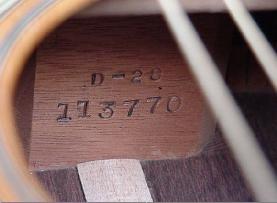
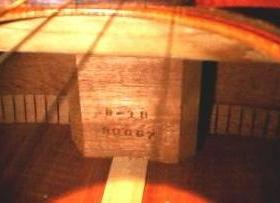
-
On round hole martin guitars, the serial and model numbers are stamped on the
neck block inside the
instrument. The number can be seen by looking inside the sound hole. Look at
an angle towards the neck. All f-hole Martin archtops have their
serial and model numbers stamped on the inside center of the backstripe, roughly
under the shadow of the bridge (and best seen from the bass side "f" hole).
The numbers listed here show the LAST serial number produced for that year. Martin produced all guitar serial number sequentially. These serial number apply to all Martin guitars, flat top and arch top. It does not apply to ukes (except for the first year, they do not have a serial number). Does not apply to Martin mandolins either (they have their own serial number system).
Year Serial# Range (produced) Year Serial# Range (produced) ---- ------------------------ ---- ------------------------ 1898 8001-8349 (349) 1950 112962-117961 (4999) 1899 8350-8716 (367) 1951 117962-122799 (4837) 1900 8717-9128 (412) 1952 122800-128436 (5636) 1901 9129-9310 (182) 1953 128437-134501 (6064) 1902 9311-9528 (218) 1954 134502-141345 (6843) 1903 9529-9810 (282) 1955 141346-147328 (5982) 1904 9811-9988 (178) 1956 147329-153225 (5896) 1905 9989-10120 (132) 1957 153226-159061 (5835) 1906 10121-10329 (209) 1958 159062-165576 (6514) 1907 10330-10727 (398) 1959 165577-171047 (5470) 1908 10728-10883 (156) 1960 171048-175689 (4641) 1909 10884-11018 (135) 1961 175690-181297 (5607) 1910 11019-11203 (185) 1962 181298-187384 (6086) 1911 11204-11413 (210) 1963 187385-193327 (5942) 1912 11414-11565 (152) 1964 193328-199626 (6298) 1913 11566-11821 (256) 1965 199627-207030 (7403) 1914 11822-12047 (226) 1966 207031-217215 (10184) 1915 12048-12209 (162) 1967 217216-230095 (12879) 1916 12210-12390 (181) 1968 230096-241925 (11829) 1917 12391-12988 (598) 1969 241926-256003 (14077) 1918 12989-13450 (462) 1970 256004-271633 (15629) 1919 13451-14512 (1062) 1971 271634-294270 (22636) 1920 14513-15484 (972)- 1972 294271-313302 (19031) 1921 15485-16758 (909) 1973 313303-333873 (20570) 1922 16759-17839 (1080) 1974 333873-353387 (19513) 1923 17840-19891 (2051) 1975 353388-371828 (18440) 1924 19892-22008 (2116) 1976 371829-388800 (16971) 1925 22009-24116 (2107) 1977 388801-399625 (10824) 1926 24117-28689 (4572) 1978 399626-407800 (8174) 1927 28690-34435 (5745) 1979 407801-419900 (12099) 1928 34436-37568 (3132) 1980 419901-430300 (10399) 1929 37569-40843 (3274) 1981 430301-436474 (6173) 1930 40844-45317 (4473) 1982 436475-439627 (3152) 1931 45318-49589 (4271) 1983 439628-446101 (6473) 1932 49590-52590 (3000) 1984 446102-453300 (7198) 1933 52591-55084 (2493) 1985 453301-460575 (7274) 1934 55085-58679 (3594) 1986 460576-468175 (7599) 1935 58680-61947 (3267) 1987 468176-476216 (8040) 1936 61948-65176 (3228) 1988 476217-483952 (7735) 1937 65177-68865 (3688) 1989 483953-493279 (9323) 1938 68866-71866 (3000) 1990 493280-503309 (10032) 1939 71867-74061 (2194) 1991 503310-512487 (9177) 1940 74062-76734 (2672) 1992 512488-522655 (10167) 1941 76735-80013 (3278) 1993 522656-535223 (12567) 1942 80014-83107 (3093) 1994 535224-551696 (16472) 1943 83108-86724 (3616) 1995 551697-570434 (18737) 1944 86725-90149 (3424) 1996 570435-592930 (22495) 1945 90150-93623 (3473) 1997 592931-624799 (31868) 1946 93624-98158 (4534) 1998 624800-668796 (43996) 1947 98159-103468 (5309) 1999 668797-724077 (55280) 1948 103469-108269 (4800) 2000 724078-780500 (56422) 1949 108270-112961 (4691) 2001 780501-845644 (65143) ---- ------------------------ ---- ------------------------ Year Serial# Range (produced) Year Serial# Range (produced)Important Serial Number Milestones.
- 439xx to 44362: October 1930 first time both the body size & style number stamped on neckblock above the serial number (exact serial number change unknown).
- 57305 = T frets first used and T bar first used (1934)
- 59044-61181 = Martin stamp in back of peghead discontinued (1935)
- 72740 = Change in nut width on 14-fret 000 and D models from 1 3/4" to 1 11/16" (late 1939), non-slotted peghead models. Style 17 models with 14-fret body may have changed earlier.
- 80585 = Ebony neck reinforcement started to be implemented during WW2 (1942)
- 83107 = Last pre-WW2 style 45 guitar (1942).
- 89926 = According to Martin, this is the approximate last scalloped braced guitar made (late 1944). Though some models have been seen after this number with scalloped braces, and before this number with tapered braces. (For example #90014 appears to be the last D28 with scalloped braces, and D-28 #88112 had tapered braces.)
- 90021 = Snowflakes on D28 discontinued (1944). This is an approximate serial#.
- 98223 = Last style 28 guitar made with Herringbone trim (early 1947).
- 99992-100240 = Last style 28 guitars made with a "zipper back" center seam (mid 1947).
- 196228 = Last guitar made at North street factory June 25, 1964. (First day at new factory July 6, 1964)
- 197207 = Bridge pin holes moved back 1/16" (1964).
- 200601 = short saddle bridge (1965).
- 205251 = 102C Grover machines on all "D" guitars (1965).
- 211040 = Boltaron bindings on D-28 and D-35 (1966).
- 212100 = Boltaron bindings on D-18 (1966).
- 213775 = Boltaron rosettes (1966).
- 215253 = New tape strips on sides (1966).
- 216736 = Bridge pin holes moved to center (1966).
- 217215 = Tortoise guards discontinued (1966).
- 220467 = Last hand stamped serial/model numbers (1967).
- 224079 = Kluson K324 tuners on all style 18 models (1967).
- 226969 = Grover v100 tuners on all 0,00,000 models (1967).
- 228246 = Square truss rod bar on D models (1967).
- 235586 = Rosewood bridgeplates on all guitars (1968).
- 242454 = Larger rosewood bridgeplates on all guitars (1969).
- 254497 = Last style 28 guitar made with Brazilian rosewood (late 1969).
- 254498 = East Indian rosewood introduced (1969, a model D-21).
- 255717 = First D-41 model with Indian Roseood.
- 256366 = First D-45 model with Indian Rosewood.
- 350287 = Plastic saddles on D-18 models (1975).
- 355357 = Plastic saddles on D-28 models (1975).
- 360970-365831 = Rosewood vertical sidestrips (1975).
- 370976 = Micarta nuts and saddles (1975).
- 447004 = Self-adhesive pickguard trial (1984).
- 447501 = Last glued-down pickguard in regular production (1984).
- 453181 = Adjustable truss rods gradually implemented (1985).
- 478093 = Maple bridgeplates on all guitars (1988).
- 737277 = Last HD-28LSV with an Adirondack top (2000). Sitka spruce was used in regular production thereafter.
Back to Table of Contents
Martin Flat Top Body Sizes.
-
"Size" is the body size designation that Martin uses, as stamped inside the
guitar on the neck block starting in October 1930. All measurements are in
inches. "Frets" represents the frets clear of the body. "Introduced"
was the year of introduction. All sizes are in inches.
Size Frets Width Depth Body Len Tot Len Year Introduced ---- ----- ----- ----- ------- ------ -------------- 1/4 12 6 3/16 2 7/8 12 (early version) 1/4 12 8 15/16 3 9/16 12 1/16 (later version) 1/2 12 10 1/8 3 3/8 15 1/16 7 12 13 11/16 4 3/8 17 1/2 5 12 11 1/4 3 7/8 16 4 12 11 1/2 3 3/4 16 3 1/2 12 10 11/16 3 7/8 16 7/8 3 12 11 1/4 3 13/16 17 3/8 2 1/2 12 11 5/8 3 7/8 17 7/8 2 12 12 4 18 1/4 1 12 12 3/4 4 3/16 18 7/8 O 12 13 1/2 4 3/16 19 1/8 1852 O 14 13 1/2 4 1/4 18 3/8 38 3/8 1932 OO 12 14 1/8 4 1/16 19 5/8 1877 OO 14 14 5/16 4 1/8 18 7/8 38 5/8 1934 OOO 12 15 4 1/16 20 7/16 1902 OOO 14 15 4 1/8 19 3/8 39 3/8 1934 OM 14 15 4 1/8 19 3/8 1929 D 12 15 5/8 4 3/4 20 15/16 1931 D 14 15 5/8 4 7/8 20 40 1/4 1934 UKES ---- Standard 6 3/8 2 5/16 9 7/16 21 Concert 7 3/4 2 3/4 11 23 1/2 Tenor 8 15/16 2 15/16 12 1/16 26 1/4 Baritone 10 3 3/8 14 30 11/16
-
Certainly the most desirable of the Martin body size is the 000, 0M, and D sizes.
Many consider the 000 (and OM, which is essentially a 000)
to be the ultimate guitar size, where others feel the "D" size is the
best. It's personal preference. There are some interesting facts though about
the 000 and OM sizes.
(In Martin's 1934 catalogue, any flattop guitar that had a 14-fret neck
was named an "Orchestra Model", while the older
12-fret design was named a "Standard Model".)
The OM Body Size.
Martin's OM, or "Orchestra Model", available from 1929 to 1933,
has a rare combination of features. The joining of a long-scale (25.4") neck
with a small body makes it an extremely responsive
and playable guitar. In many ways the
OM models were the first truly modern flattop guitars.
They were the first Martins to have necks with 14 frets clear of the body.
The OM has a wide neck (1 3/4" as opposed to the dreadnought's 1 11/16")
which appeals to fingerstyle players. The string spacing is slightly greater at
the bridge than on other models too, although not as wide as a classical guitars.
The neck shape of old OMs is a bit unique too, although this is
variable since each neck was handmade. OMs have a
wide but thin backshaped V-shape which is very comfortable.
Finally, the OM's smaller body size makes the guitar easy to hold,
especially in the seated position. Compared this to the
D dreadnought which is larger both in body depth and width
(dreadnought players seem to use straps and stand up so the
guitar's size is less of a factor).
The OM model came about due to Perry Bechtel, who was a virtuoso plectrum banjo player. Perry came to see the Martin family in the early summer of 1929. He wanted Martin to make him a guitar which he could easily adapt his banjo style (remember by the late 1920s guitar was the hot instrument, replacing the banjo). He requested 15 frets clear of the body and a 27" scale in Martin's largest standard body size (which at that time was the 000, with 12 frets clear of the neck). The 27" scale would retain the fret spacing of the plectrum banjo, and 15 frets clear of the body would closely resemble the length of a banjo neck.
Martin began with a 000-size guitar, which had 12 frets clear of the body. They rejected the 27" scale idea, as this would have been impractical since the high string tension on a guitar would have made the instrument hard to play. Instead they used a 25.4" scale length. To accommodate Bechtel's request for 15 frets clear of the body, they squared the body's shoulders to add 1 5/16" to the clear part of the fingerboard. This allowed 14 frets clear of the body. Since they felt aesthetically the bridge should remain halfway between the center of the soundhole and the endblock, there really was no way to make the guitar have 15 frets clear. The bottom bout was reshaped slightly to match the new shape of the upper bout (note when the 000 went to 14 frets in 1934 it retained this initial OM body shape).
To make the OM more suitable for banjo players, the neck was made narrower and less V-shaped than previous Martins. The fingerboard was narrowed from the then-standard 1 7/8" to 1 3/4" at the nut. In addition to make the OM more banjo-like and to give it a distinctive look, banjo style tuning pegs were used. To do these, the headstock had to be made solid, instead of slotted. Previously Martin headstocks had all been slotted with tuners attached to the side mounted on a single plate for three tuners. No single-unit guitar tuners were available, so banjo pegs were a natural.
In late 1929, Martin built a prototype batch of six OM guitars. The very first of these had pyramid bridges and no pickguard. Martin soon realized that with the vigorous strumming required in a band setting, a pickguard would be required. Hence all OMs after the prototype batch had a small teardrop-shaped pickguard. The new OMs were not highly sucessful. They sold, but not as well as Martin had hoped. In 1933 the OM designation was dropped and was now called the "000" model. But infact the 1933 "000" models were the same as the 1933 "OM" models, retaining the OM body style and 14 fret neck. Then in 1934 the standard 000 models were modified to the shorter 24.9" scale (for unknown reasons, as the 12 fret 000 body had a 25.6" scale length its inception in 1902 to its demise in 1931). Yet the OM's longer scale was a major factor in the OM's tone. The strings on an OM must be tuned to a higher tension to get concert pitch. This extra tension translates into more drive on the top, hence providing more volume and tone. The OM's scalloped braces and a small maple bridgeplate give the OM a great sound. Although these features were common to other Martin models of the time, the OM's top brace under the fingerboard was missing. This design is unique to OMs making the top very lightly braced. This does lead to some problems with cracks in the upper bout along the side of the fingerboard, but it also contributes to the great sound of the OM models.
Back to Table of Contents
Martin Flat Top Production Years by Model.
-
This should give you an idea of when the majority of the production for
any one model occured (majority meaning more than 5 instruments per year).
Note this does not mean a model can not exist outside of these years -
it certainly can. Just these are the years recorded by Martin in their
ledgers. Note this list (for the most part) does not go past 1969.
Model More than 5 Less than 5
----- ----------- -----------
1-18 1899-1927
1-21 1898-1926
1-28 1898-1923
1-42 1898-1904 1911-1919
1-45 1904-1919
2-18 1898-1900 1902-1925, 1929, 1938
2-45 1925-1927
5-18 1919-1981 1898-1917
5-21 1927 1902-1920
5-28 1901-1939
O-17 1929-1948 1966, 1968
O-17H 1930-1940
O-17T 1933-1960 1932
O-18 1898-1983 1985-present
O-18K 1918-1935
O-18T 1929-present
O-21 1898-1948
O-21K 1920-1926 1927-1929
O-28 1888-1931 1937
O-28T 1931-1932
O-28K 1921-1931 1917
O-42 1898-1930
O-45 1919-1930 1904-1918
OO-17 1930-1960 1908-1917
OO-18 1898-1981
OO-18G 1936-1962
OO-18C 1962-1976
OO-18K 1918-1925
OO-21 1898-present
OO-28 1898-1936 1939-1941
OO-28G 1936-1962 1936-1937
OO-28C 1966-1976
OO-28K 1919-1921 1926-1933
OO-30 1899-1921
OO-34 1898-1899
OO-40 1913-1917
OO-40H 1928-1939
OO-42 1898-1942 1935-1938
OO-45 1919-1929 1904-1918
OO-55 1935 (same as 00-17, special order by Rudick's, Akron OH)
OOO-17 1952
OOO-18 1923-present 1911-1922
OOO-21 1938-1959 1902-1923
OOO-28 1924-present 1902-1923
OOO-28C 1962-1966
OOO-42 1938-1943 1918-1925
OOO-45 1924-1942 1906-1923
OM-18 1930-1933
OM-28 1929-1933
OM-45 1930-1933
OM-45DLX 1930
D-18 1931-present
D-21 1950-1969
D-28 1931-present
D-35 1965-present
D-41 1969-present
D-42 1986-present
D-45 1934-1942,
1968-present
----- ----------- -----------
Model More than 5 Less than 5
Back to Table of Contents
-
Serial Number and Size/Style Number Stamps
- 1898 to present: flat top serial number stamped inside on neck block.
- Oct 1930 to present: flat top model number stamped inside on neck block around serial number rant 439xx to 44362 (exact serial number change unknown).
- All Martin f-hole arch tops have the serial and model number on the inside center backstripe.
- Some letter suffixes clarify styles:
- A = ash
- B = Brazilian Rosewood
- BK = Black finish
- C = classical
- DB = Deep body
- E = electric
- FMG = Figured Mahogany
- G = Gut string classical
- GE = Golden Era
- GM = Grand Marquis
- H = Hawaiian style
- K = Koa wood back & sides
- K2 = Koa wood back, sides and top
- L= Left handed
- LE= limited edition
- M = Mahogany (of if a "J" prefix is used, Jumbo M body size)
- MB = Maple Binding
- MP = Morado back and sides and low profile neck
- N = Non-low profile neck (when low profile necks were standard)
- P = Plectrum (pre-WWII), low profile neck (1985 to present) or Fishman Prefix pickup
- Q = Old style non-adjustable truss rod neck (1985-present)
- R = Rosewood back and sides
- S = special order (pre-WWII) or 12 fret neck (1967 to present)
- SE= signature edition
- SW = Special Wurlitzer
- T = tenor
- V = vintage specs
- W = Walnut
1920's Martin. This model had no peghead decal
declaring it was a Martin, so this stamp sufficed
on the back of the peghead.
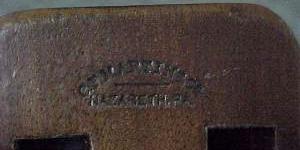
-
Martin Stamps, Peghead Logos, Labels.
- 1833-1840s: Paper label "Christian Frederick Martin" or "C.F. Martin".
- 1836: Some with paper label "Martin & Schatz".
- 1838: Some with paper label "C.F. Martin and Bruno".
- 1838: Martin manufacturing moved from New York to Nazareth PA.
- 1840s: Some with paper label "Martin & Coupa".
- 1833-1866: Stamp "C.F. Martin, New York" on inside backstrip.
- 1867-1897: Stamp "C.F. Martin & Co., New York" on incide center backstrip.
- 1880s-1900s: Date often written in pencil on the bottom side of the top of the guitar by the factory foreman (can be seen with a lighted mirror).
- 1898-1935: Stamp "C.F. Martin & Co., Narareth Pa" on back of peghead & center backstrip.
- 1922-1923: Martin makes guitars for Wurlitzer. Some lack Martin serial numbers or any markings of any kind.
- Late 1931: "CF Martin & Co, Est. 1833" silkscreened on front of peghead with NO black border around letters (the silkscreening process was a single gold color). This appeared on OM models.
- 1932: OM-18 and OM-28 got peghead Martin decals, replacing the gold silkscreened logo.
- 1933: Nearly all Martin models had a "Martin" peghead decal.
- Mid 1934: "CF Martin & Co, Est. 1833" decal on front of peghead with black border around the letters (the decal used both gold and black colors). Silkscreen logo no longer used.
- Mid 1935: Stamp "C.F. Martin & Co, Narareth Pa" on back of peghead no longer used (in the 1932-1934 era both the front silkscreen and back stamp are used.) The back peghead stamp was discontinued between serial number 59044 and 61181. (Interestingly the neck block stamping with model serial numbers started between Oct.1 and Oct.15th, 1930.)
- 1940-1942: Some style 15 and style 17 models have a tortoise shell celluloid peghead veneer (instead of the normal rosewood veneer), with a decal "Martin" logo. Seen mostly in 1941, the model 0-15 seems to this option the most. This celluloid peghead veneer is the same as the pickguard material.
- Mid 1935-1963: Stamp "C.F. Martin & Co, Narareth Pa" on center backstrip only, as seen through the soundhole.
- 1961-present: "MADE IN U.S.A." designation added on the center backstrip. This appears to have started around serial number range 174xxx to 175xxx.
- Mid 1960s: the bar across the "F" in "CF Martin" on the peghead decal changes from a straight bar to a curved bar (like a tilda on a keyboard).
Older 1800s Martins are a challange to date (since they don't have a serial number like 1898 and later Martins). A "New York" stamp does not immediately suggest that the Martin guitar is from the 1830s for example. To accurately date pre-1898 Martins you must be familiar design and ornamentation appointments and the changes that took place in each model throughout the 1800s. Most useful though is the stamp, but you can only use the stamp on the INSIDE of the body on it's center backstrip (visible through the soundhole) to date a guitar. And even then you can only date to a period (and not to an exact date). For example if it says on the center back strip, "C.F. Martin, New York", then the guitar is pre-1867. If it says, "C.F. Martin & Co., New York", it is between 1867 and 1897. Note 1860-1890s Martins have a date (year of manufacture) penciled on the underside of the top. Check with a mirror, looking just below the soundhole and between the braces.
1934 Martin 0-17 peghead with a silkscreened logo.
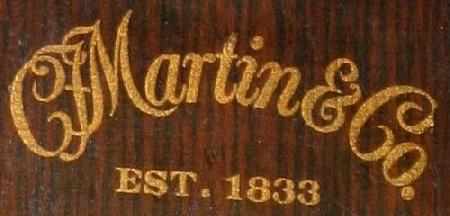
1934 Martin 00-18 peghead with a decal logo.
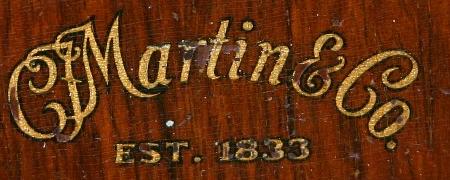
1942 Martin 0-15 celluloid peghead veneer with a decal logo.
Note the lack of tuner ferrels because of war-time metal shortages.
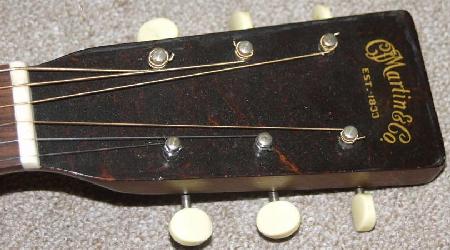
-
Tops (Style 18 and higher)
- 1919: Martin experimented with Sitka spruce tops on some guitars. (but Adirondack red spruce was the standard top material).
- 1927: top gets a bit thicker to accomodate steel strings. Note this is not a "for sure" rule.
- pre-1946: Adirondack red spruce (1946 guitars can have either Adi Red Spruce or Sitka).
- 1946 to present: Sitka spruce (darker than Adirondack). The change to Sitka happened on the larger "D" models first (in very early 1946). It took Martin a little while to use up all the smaller pieces of older Adirondack red spruce, hence the change to Sitka happend slower on the smaller body models. This is also the reason multiple piece Adi red spruce tops are sometimes seen on 0,00,000 bodies in 1946.
- 1950s: occasional Adirondack red spruce. In 1952 or 1953, rumor has it Martin bought a large supply of Engelmann spruce from government surplus. Though Martin preferred Adirondack Red Spruce, it was no longer available after the mid-1940s because all of the large trees had been decimated. Martin would have liked to switch from Sitka to Engelmann because he felt that Engelmann was closer to Adi Red Spruce than Sitka was. He could not however find anyone who was cutting Engelmann commercially, so they went back to Sitka.
- Present: some with Engelman spruce.
"Split Diamond" style inlays as used
on pre-1945 style 21 and 28 guitars.
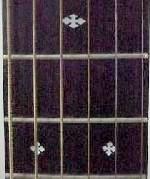
-
Rosewood Back and Sides (Style 21 and higher)
- pre-late 1969: Brazilian rosewood (ended with serial# 254497).
- 1969: slab-cut Brazilian rosewood instead of the more traditional and desirable (in terms of appearance, strength, and warp-resistance) quartersawn rosewood.
- late 1969 to present: Indian rosewood. First Indian Rosewood model was a D-21
serial number 254498. Note even though the cut off for Brazilian rosewood was
serial number 254497, some high-end models like the D-45 and D-41 did appear after
this serial number with Brazilian rosewood bodies. For example:
254498: first Martin with Indian rosewood (D21).
255037: D12-45 with Indian rosewood.
255717: first D-41 model with Indian Rosewood.
256366: first D-45 model with Indian Rosewood.
- Occasionally (and rare) Brazilian rosewood shows on on random models in 1970 (probably from leftover rosewood). For example 265783 and 265941 (both 1970 D-28 models). Also some D-35 models with mixed woods in the 3-piece back like number 258962 which had a Brazilian rosewood center wedge in the back.
- Brazilian rosewood is more figured than the very straight grained Indian rosewood. Also Brazilian is usually a dark redish brown, where Indian is a light brown.
Back removed from a Martin showing the neck block and two top braces.
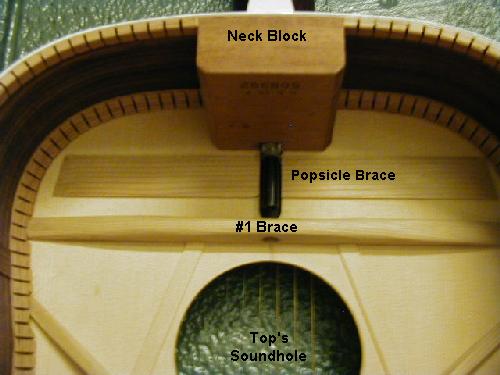
-
Bracing
- 1840s to 1938: Scalloped "X" bracing, position of the cross of the "X" bracing one inch from edge of soundhole, aka "forward braced" or "advanced bracing".
- 1927: bracing dimensions and top thickness increases to accomodate steel strings. Note this is not a "for sure" rule.
- Late 1938: Scalloped "X" bracing with "rear shifted bracing", where position of the "X" moved further than one inch from soundhole (exact measurement varies, for example: a 1941 D-18 has 1 7/8" distance). So the X-braces were moved about 7/8" further down. And the tone bars were angled more parallel with the length of the guitar and further apart. These late-1938 to late-1944 guitars had deeper scalloped braces than the 1938 and prior forward or advanced braced guitars. This gives the late 1938 to late 1944 Martin guitars improved bass response (don't let anyone tell you that war-time Martins are not as good as pre-1939 Martins!)
- mid-1939 Popscicle bracing on D body sizes.
See the above picture for what the popsicle or T-6 or upper transverse graft brace is.
The popsicle brace was added to the underside of the top of the guitar, below the fingerboard.
The brace was added to help prevent top cracks alongside the fingerboard.
Since the first D body size was made in about 1934, problems obviously came about
and Martin added the brace by 1939. The brace does not appear in pre-1939 Martin
D-sizes, but transitioned in around 1939, and is present in all 1940 and later
D models. Without the popsicle brace, the top is attached only by the strength
of the spruce fibers and a 1/2" x 2" glue area where the top overlays
the soundhole #1 brace. With the popsicle brace there is an
additional 1" x 2" glue surface directly under the fingerboard. Unfortunately
the popsicle brace can deaden the sound of the upper bout area of the soundboard,
and the popsicle brace doesn't always prevent the top from cracking
along the fingerboard either.
As people search for why the old Martins sound so good, they examine every
aspect of them and the popsicle brace usually enters the conversation.
Here's some data on popsicle braces:
1938 D-18 #71539 rear-shifted X-brace, no popsicle brace.
1939 D-28 #71968 rear-shifted X-brace, no popsicle brace.
1939 D-18 #72618 1 3/4" neck width, no popsicle brace.
1939 D-18 #72702 1 3/4" neck width, popsicle brace (stamp 23 May 1939).
All 12 fret Martins have the popscicle stick brace too. - 1939: The #1 brace inside near the neck block changes from 5/16" wide to 1/2" wide, making it roughly twice as wide. This happened at the same time as the popscicle brace addition. The neck block thickness was also reduced by 1/4". About the same time neck width reduced from 1 3/4" to 1 11/16" at the nut, and the bridge spacing reduced from 2 5/16" to 2 1/8".
- Late 1944: According to Martin, the last scalloped braced Martin in late 1944 was approximately serial number 89926. Though some models have been seen after this number with scalloped braces, and before this number with tapered braces. (For example #90014 appears to be the last D28 with scalloped braces, and D-28 #88112 had tapered braces.)
- Late 1944 to 1976: Heavy straight "X" bracing (not scaloped), position of the "X" still further than one inch from soundhole (exact measurement varies, for example: a 1958 000-18 has 1 3/4" distance, and a 1967 000-28 has 1 13/16" distance).
- Late 1944 to about 1949: the bracing was tapered. This stopped in the late 1940s, and was a progressive thing. So unlike scaloped bracing that had a definate endpoint, tapered braces evoloved into "straight" braces by 1949. This is why 1945-1949 Martins are still highly regarded as "better" than their 1950s counterparts, but not as good as the 1944 and prior scalloped braced guitars.
- 1948: Bridgeplates are no longer notched into the X-braces.
- 1949-1976: Straight braces (neither scalloped or tapered.)
- Circa 1960: X-bracing moves back up to 1 1/2" from soundhole.
- 1964: Hot hide glue phased out with the move to the new factory. Hot hide glue continued to be used to attach the top to the body.
- 1968: Small maple bridgeplate (1 3/8") replaced by small rosewood bridgeplate.
- 1969: Small rosewood bridgeplate replaced with large rosewood bridgeplate (3 1/4").
- 1976 to present: Scalloped bracing re-introduced on some models (HD-28, D-45 in 1985, D-41 in 1987). Also one inch "X" bracing used again in the late 1980s on many "D" models.
The pre-1945 braces have a scooped or "scalloped" profile, making them lighter in design and weight. Functionally this means a greater vibrating surface (the guitar's top), and provides stronger bass response. Why did the Martin Company change from the lighter scalloped braces to heavier braces? The answer is in the strings. Many guitarists of that time were using heavier gauge strings, and these heavier strings were tough on the lightly constructed scalloped-braced Martins (especially on D-models with the long 25.4" scale). Martin didn't make a heavier guitar to withstand the extra string tension, so they compensated by adding more rigid (non-scalloped) braces to the guitar's top.
braces (top) versus non-scalloped straight braces (bottom).
Pics are showing the underside of the top, right beneath
the bridge (notice the bridge plate) and looking towards
the end block. Note the straight braced picture has a
Rosewood bridge plate, meaning this guitar is 1968 or later.
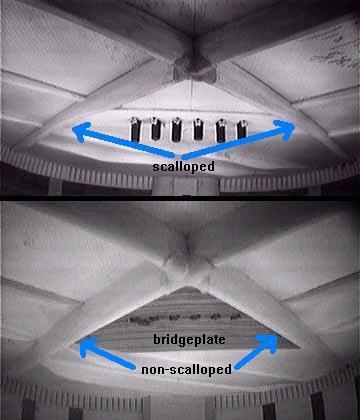
1946 Martin D-28 with tapered braces:
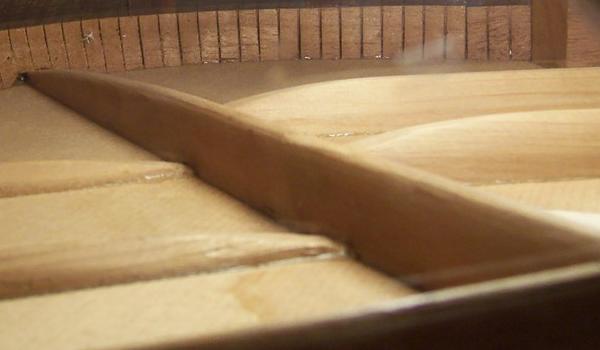 1955 Martin D-28 with straight braces:
1955 Martin D-28 with straight braces: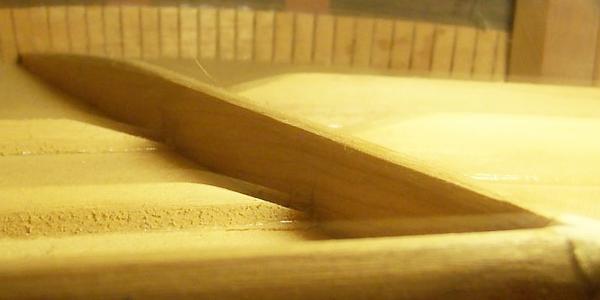
-
Flat Top Bridge Plates
- 1927: bridgeplate becomes thicker on most models to accomodate steel strings. Note this is not a "for sure" rule.
- 1932: bridgeplate were enlarged from 1" to 1 3/8" on all belly bridge styles (style 18 and higher). Style 17 (mahogany top) models that didn't get a belly bridge stayed with the smaller 1" bridge plate.
- Pre-April 1968: Maple bridge plate on all models. Serial number 235585 was the last maple bridgeplates on all guitar models (4/68).
- April 9, 1968 to 1987: Rosewood bridge plate on all models starting with serial number 235586. This had a somewhat dramatic change in sound for all Martin models, and is really the end-point in collectibility for many people.
- 1969: with serial number 242454 a larger rosewood bridge plate was used on all guitars. This made sound even worse (but probably made the Martin repair & warranty department happy as the guitars were less prone to bridge damage).
- 1976: HD-28 uses maple bridge plate.
- 1988 to present: Maple bridge plate re-introduced on all models with serial number 478093.
A maple bridge plate is the most desirable. The use of rosewood for the bridge plate starting in April 1968 is largely to blame for the lack of "good sound" on 1968 to 1988 Martins.
Flat Top Pin Bridges.
Left: Pre-1965 style belly bridge with a "long saddle"
which extends past the "dips" in the bridge.
Note the "snake eye" bridge pins with tortoise
shell dots inlayed into them. These are used
on style 28 models.
Right: Rectangle style bridge with "pyramid" ends.
Not all pyramid bridges have straight saddles.


Ivory pyramid bridge on a 1885 0-34 guitar (pic by PhotoRC).

-
Flat Top Pin Bridges
- 1920s: Martin transitions away from pyramid long bridge to standard rectangle bridge on style 18 and style 28 models. Happens gradually with the style 17 series never having a pyramid style bridge or transitioning earlier to the rectangle bridge. Note that all pyramid bridges have a straight saddle.
- 1927: Generally thought of as the year all models were braced for steel strings. Note this is not a "for sure" rule.
- Pre-1929: All size 1 and larger guitars, from any year, have 6" long pyramid bridges. All size 2 or 2 1/2 Martins have 5 3/4" to 5 7/8" long pyramid bridges. Most pyramid bridges before 1900 are roughly 7/8" wide, and most after 1900 are 1" wide. The average length of the wings on most pyramid bridges is roughly 1 3/8" During the 1880's and 1890's, however, there is more variation, as much as from 1 1/4" to 1 1/2" On the earlier 7/8" wide bridges, the wings have a very long, narrow, elegant appearance, with a gentle curve to the inside angles of the pyramids, that looks nothing at all like the harsh angles found on many copies. There is no difference between the dimensions of ivory and ebony bridges from the same period.
- 1929 and earlier: Rectangle bridge or pyramid bridge (on some style 28 and higher models). By late 1929 the pyramid bridge was no longer used and the rectangle bridge was only used on style 17 and lower. Some OM models were the last to use the pyramid bridge as late as 1930.
- Late 1929 to present: Belly bridge, style 21 and higher, about 3/8" tall and 1.4" wide. Style 18 and lower retain the rectangle bridge.
- 1930/1931: Belly bridge on style 18 guitars. Style 17 and lower (mahogany topped models) retain the rectangle bridge.
- 1939: Neck width reduced from 1 3/4" to 1 11/16" at the nut, and the bridge spacing reduced from 2 5/16" to 2 1/8".
- 1965: Shorter bridge slot on all bridges, known as the "drop-in" bridge saddle. Pre-1965 bridges are known as "long saddle" bridges.
As a conservative approach to using steel string, one thing is pretty much for sure; if a Martin came from the factory with a Belly bridge, it is braced for steel strings. If it has a rectangle bridge (and was made before 1929), the bracing needs to be checked by a qualified repair person to determine if the guitar's bracing can handle steel strings. My personal opinion is if it's a style 18 or higher and has a rectangle bridge and was made before 1930, it's not really made for steel strings. Though 1927 is generally thought of as the year when most models were braced for steel strings, 1927-1929 models could be braced for either steel or gut strings. So before putting on steel strings on a 1927-1929 Martin, have it check out by a good repair person. They will check the top's firmness, bracing dimensions, and bridge plate thickness.
"Braced for Steel Strings."
When talking about 1920s Martin guitars, you hear people
say this a lot (especially if they are trying to sell you
a guitar!) Unfortunately there is no definative way to tell
if a 1920s Martin is capable of handling steel strings.
The term, "braced for steel strings", though is inaccurate.
A better way to put it would be, "built for steel strings".
For a 1920s Martin to be built for steel strings there were several
small changes - the top, braces and bridge plate are all slightly thicker.
Can you see this inside the guitar?
For the most part, no, unless you really know what you
are looking for (frankly I can't tell). So how do you
know if a 1920s Martin is built for steel?
Notice the steel strings are not pulling the top/bridge.
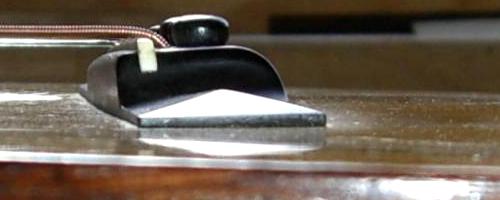
-
First the lower line models were
built for steel strings first. Like the style 17 in 1922,
and the style 18 in 1924. Pretty much all models were
built for steel by 1927-1929. But unfortunately there was no
definative serial number or time line for any 1920s Martin
style. This makes it difficult to determine if any
particular 1920s Martin guitar is really built for steel strings.
Martin didn't just implement steel string design at any
one definative point. It was a transition, and apparently
a very slow transition. And special orders for gut or steel
complicated things.
- Martins made before 1922 were not built for steel strings.
- Most Martins built after 1927 should be able to handle light gauge steel strings.
- Style 17 built 1922 and later should be able to handle light gauge steel strings.
- Style 18 built 1924 and later should be able to handle light gauge steel strings.
- Style 21 and Style 28 guitars built after 1927 should be able to handle light gauge steel strings.
- OM styles with banjo tuners should be evaluated with care (light guage steel strings at most).
- All styles built 1934 and later should be able to handle medium gauge steel strings.
- pre-1928: no pickguard.
- 1928 to 1967: Tortoise grain celluloid pickguards glued directly to the top, clear finish then applied over top and pickguard. Due to extreme shrinkage of celluloid and lacquer, this often causes a "pickguard crack" in the top. Pickguards became "standard" in 1931 on most models, but some martin guitars had them as early as 1928. The OM series was the first model to consistently have a pickguard in 1930.
- 1967 to 1980's: Black plastic pickguard glued directly to the top, clear finish then applied over top and pickguard. Due to shrinkage of the plastic pickguard and lacquer (though the black guard didn't shrink as much as celluloid), this often causes a "pickguard crack" in the top too.
- 1984 to present: Tortoise grain celluloid pickguard, double-sided taped to finished top with no finish on pickguard (to accelerate shrinkage). Pickguard is now independent from the top and "gives" and can move without cracking the top.
The conservative way to tell if a Martin is built for steel strings is the bridge. If it's a style 18 or higher and has a belly bridge (and does not have 'banjo' tuners like early OM models), it's pretty much built for steel strings (can't use this indicator on style 17 and lower as these models never used a belly brige until the 1950s). Why? Since Martin didn't implement the belly bridge until late 1929, it's a very conservative indicator that the guitar is built for steel. The belly bridge was the last thing they did to make steel strings usable on their guitars (though certainly many models with rectangle bridges can handle steel strings too.) They started to implement the belly bridge in 1929, and all style 18 models and higher had the belly bridge by 1930. Therefore using the belly bridge as a steel string indicator is a very safe idea (assuming the bridge is original and it's not an OM). Now can steel strings be used on pre-1930 models with a pyramid or rectangle bridge? Maybe, but it's just not as definative and caution should be heeded ("silk and steel" strings would be a good and safe compromise). Note early OM models with banjo style tuners generally should be strung up 'lightly'.
Here's some general 'rules' to consider in regards to using steel strings. But remember all 1920s Martins should be evaluated individually by a good repair person, checking the top around the bridge for firmness and pull.
Keep in mind that the year the guitar was built is no guarantee that any individual guitar is in the optimum condition required to handle steel strings. Any Martin should be evaluated with care, and a top that lifts significantly in the bridge area or this is not firm, is a sign that lighter strings should be used. Or that the guitar is in need of attention by a qualified repair person.
Conpensated Bridges.
With the advent of belly bridges in 1931, Martin started to compensate their
saddle placement. What this does is make for better string intonation. However
early pyramid bridge have straight saddles, mounted 1/8" back from the front edge of the bridge.
(with the center of the pin holes 3/8" from the back of the saddle.)
The 1931 to 1933 belly bridges have a compensated saddle placed 1/8" from
the front of the bridge on the treble side, and 3/16" from the bass side.
Then on belly bridges in the mid 1930s Martin moved the bass end of the saddle back to
1/4" from the front of the bridge.
Bridge Pins.
Bridge pins prior to 1945 did not have string slots. There is a slight seam seen
in the round head (hard to see but it's there).
The bridge pin round head diameter from 1931 until mid-1939 was about 0.320".
In mid-1939 the round head was reduced to about 0.300", and this size was used
until the unslotted pins ended in 1945. The shaft size was slightly increased
at this time too. The pre-1939 style pins have a more
bulbous head, where the 1939-1945 style's head is more slender.
The pin taper is about 5 degrees, and the diameter under the collar is about 0.225".
The pins are made of hard celluloid. Several companies have reissued these old
style pins.
Rectangle Bridges.
After steel strings were the norm, rectangle bridges were still used on the
lower end Martin models and smaller body models. Bridges don't last forever
unfortunately, and the rectangle models are easy to reproduce. Hence here's
some specs that may help you determine if a rectangle bridge is original.
A Martin rectangle bridge should be 6" long and 1" (or slightly less) wide.
The top of the bridge should have close to a 16" radius lengthwise.
The tallest point of the bridge should be between the A & D strings,
and the lowest at the high E string. The wing thickness is about .095".
Flat Top Pickguards
Left: Herringbone binding as used prior to 1947 on styles 21 and 28 guitars.
Right:"Zipper" backstrip as used on pre-1947 style 28 models.
Also note the nice Brazilian rosewood used.
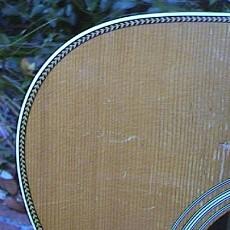
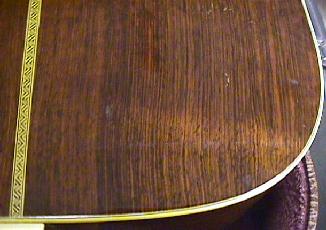
-
Binding Material
- pre-1918: Elephant ivory binding on styles 28 and higher.
- 1918 to 1966: Celluloid grained "Ivoroid" binding on styles 28 and higher.
- 1934: Black plastic replaces wood on styles 18, 21.
- 1936 to 1966: Tortoise grain binding used on some styles 18, 21.
- 1966 to present: Black plastic binding on styles 18, 21.
- 1966 to present: White non-grained (Boltaron) binding on styles 28 and higher. Black binding replaced tortoise binding on style 18 models.
- 1860 to early 1947: Herringbone binding on styles 21, 28 (last serial# 98223).
- 1947: Zig-zag "zipper" backstrip discounted on style 28 (last serial# 99992).
- early 1947 to 1980's: Black/white stripped binding on styles 21, 28.
- 1980's to present: Herringbone binding on styles 28.
- pre-1900: French polish.
- 1900: Thin shellac.
- 1919: Semi-gloss shellac.
- 1923: High-gloss shellac.
- 1926 (some models), 1929 (most models): Clear nitrocellulose lacquer. Style 18 models fully switched over to nitro cellulose lacquer by 1929. The transition from shellac to lacquer started in 1926 with O-17H.
- 1930: All styles have nitrocellulose lacquer finish.
The herringbone purfling (binding) was discontinued on style 28 guitars in 1947. The binding was made in pre-World War II Germany and was not replaceable from American sources. When the stockpile ran out in early 1947, D-28s (and all style 28 guitars) were bound with a new decoration scheme of alternating black and white celluloid (originally used on the Martin archtop C-2 model). Hence the term "herribone D-28" or "bone 28" is heard amoung Martin collections, signifying a pre-1947 style 28 Martin guitar.
Glue
In the fall of 1964, it's generally accepted that hide glue was replaced with
white polyvinyl acetate PVA glue (Elmer's) after the move to the new Martin build facility.
(But hide glue was still used until the mid-seventies for gluing tops to the rim
and in some other situations.) A notation was written in Grant Remaley's personal memos
on Sept 29, 1964 indicating Martin was starting to use "cold" glue.
It is generally thought the type of glue used does affect the sound of the guitar.
Starting some time in the 1980s Martin started switching from white glue to
yellow aliphatic resin (titebond).
Finish
Right: Bar style frets. Later "T" style frets stay in the fingerboard better because of the "barbs" or tangs on the side of the "T".
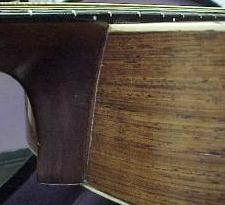
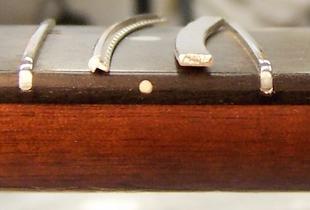
- 1830s to 1916: two piece cedar neck with grafted peghead and "long" volute (which gave more glue surface for the separate peghead). Some models also used a three piece neck with no volute and a separte "ice cream cone" neck heel and clock style key fastening method.
- 1916 to present: One piece mahongany neck. Style 28 and higher now have a shorter volute (which is mostly ornamental).
- 1929 (OM models): 14 fret neck introduced on flat tops.
- 1929-1934: All the new 14 fret neck models have a 1 3/4" wide neck width at the nut (prior to this all 12 fret neck models had a 1 7/8" wide neck width).
- 1932: Some style 17 and 18 models transition to 14 frets clear of body with non-slotted peghead.
- 1934: 14 fret neck standard on all flat tops models except the 000-21 (it became 14 fret in 1938).
- Slot Peghead vs. Solid Peghead (steel string models): Most models converted from a 12 fret slot peghead to a 14 fret solid peghead around 1934 (except the OM series, which went 14 fret in 1929/1930 and the style 17 and 18 models which were available in 14 fret style in 1932). Basically if the guitar has a 14 fret neck, it will have a solid peghead. If it has a 12 fret neck, it will have a slot peghead. Note there were some post-WW2 gut string and classical models (i.e. 0-16NY) and some post-WW2 special order steel string guitars (i.e. 1967-1993 D-18S) which always have a slotted peghead.
- Late 1934: "T" frets (aka tang frets) replace Bar frets on flat tops. (Most other guitar makers had stopped using bar frets much earlier.) Martins Hawaiian style guitars retain bar frets until at least 1938. The first Martin model to use T frets was the 00-17, introduced on a lot of 00-17 guitars #57305-57329 in 1934. Initially the first T-frets were special ordered by Martin to contain 30% nickel ("normal" fret wire is 18% nickel, 65% copper and 17% zinc). The higher percent of nickel, the harder the fret wire. This special 30% nickel fret wire was ordered from the Horton-Angell Company (the inventor and patent holder for barbed alternating "fish hook" T frets) on 8-31-1934 in an 100 pound lot, along with 100 pounds of "normal" 18% nickel fret wire. It's unclear if Martin ever used 30% nickel fret wire after this, because it was more expensive and not the norm. The same instruments also introduced the "T" neck reinforcement bar. Shortly thereafter T frets were standard. (Like with steel strings in 1922, Martin tried these innovations first on inexpensive low-end models to minimize financial damage in case the experiment was a failure.)
- 1939: switch from 1 3/4" wide nut-width to the narrower 1 11/16" at serial #72740 for all non-slotted peghead 000 and D models.
- After 1916, only Style 28 and higher has an "ice cream cone" style volute on the back of the one-piece neck. Styles 21 and lower lack this.
- All years: Martin painted the neck and body of their flattop guitars apart and separately when made. After both are dried and rubbed out, then the neck is glued to the body. Because of this, there should never be any finish in the seam between the neck and body.
- 1928-ish: Ebony neck reinforcement under fingerboard for strength.
- Late 1934: Steel "T" bar. Thickness varies, but generally speaking both sections of the T is 0.125", width and height is 0.525" (kind of like Flexible Flyer sled runners). The bar is glued into the neck with Hide glue.
- 1942: Ebony neck reinforcement under fingerboard (war time shortage of steel)
- 1945/1946: Steel T bar again used sparatically (varies between ebony and steel during these years.)
- 1947: Steel T bar.
- 1967: Square steel bar.
- 1985: Adjustable (inside body) steel truss rod.
Neck and Frets
Neck Truss Rod.
Waverly tuners (pointy base plates), and the "ice cream cone" volute.
Middle: Back of a D-18 war-time Martin. Note the tuners
have plastic buttons, as used during WW2. Also no
"ice cream cone" volute on styles 21 and lower models.
Right: Back of a 1946 D-28. Note the different open
back Grover G-93 tuners, and the "ice cream cone" volute.

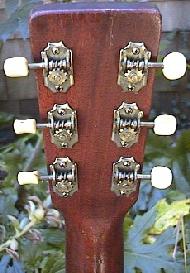
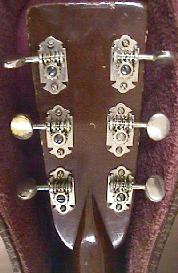
1934 Martin 000-18 with Grover G98 tuners. Note the riveted gear and the base plates
that are not pointy (cut flat), and the slot head mount screws.
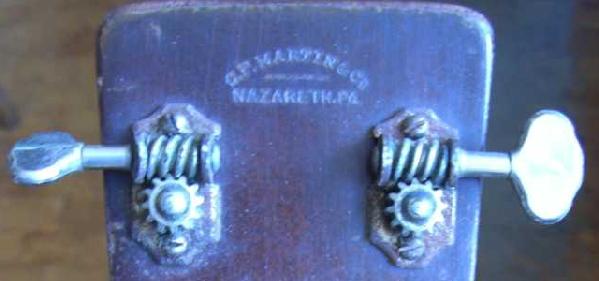
Original slotted peghead Grover tuners on a 1931 Martin 00-21.
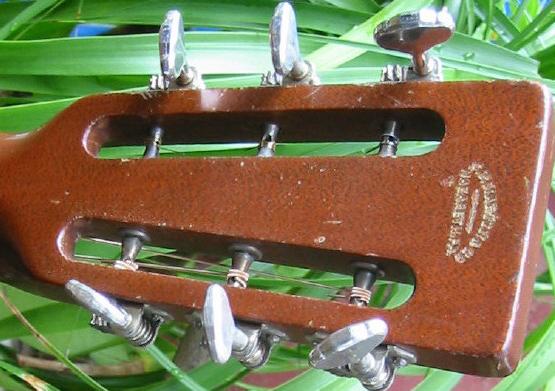
-
Tuners.
- 1916: Gear wheel above worm gear, ivoroid buttons.
- 1925: Gear wheel below worm gear, ivoroid buttons.
- 1929: On slotted peghead style 21 and above used Grovers. These had an hourglass shaped string shaft with the shaft fitting into a metal bushing in the inner (center) wall of the peghead. The tuner gears were peaned to the shafts rather than screwed. The tuner buttons had the familiar Grover clover shape.
- 1929: Grover planetary banjo tuners on OM models only. Discontinued 1931 in favor of the open back standard Grover tuner.
- 1931: Solid peghead guitars had open back Grover tuners with no gear adjustment screw and thin metal scaloped buttons (seam in middle of button). Grover base plate tips are squared off.
- 1935: Archtop models C-3 and F-9 have gold Grover G-98 tuners with an engraved "M" on the butterbean buttons.
- mid 1939-mid 1940: On style 28 and higher; sealed back Grover tuner, heavy metal thick buttons (no visible seam).
- 1940: Grover G-98 open-back tuners with "butterbean" buttons used on many models from style 18 and higher.
- 1942-1946 (War time): Open back Kluson tuners with no gear adjustment screw and plastic buttons, no peghead bushings. This was done to minimize metal usage.
- 1946: Open back Kluson tuners with gear adjustment screw. Tuners get metal buttons and again have metal peghead bushings.
- 1947: Kluson Deluxe tuner on all D body sizes (any style), and all style 28 models.
- 1947: Open back Grover Sta-tites on 0, 00, 000 models style 21 and lower. These post-WW2 open back Grovers have thin seamed buttons and the pointed baseplates which were never used on the pre-war open back Grovers. Also all the pre-war thin seamed button tuners were 6:1 ratio. The post-war tuners (and the thick-button open Grovers after 1937) were 12:1 ratio This makes post-war open back Grovers more easily identifible. Otherwise the post-war Grovers are direct drop-in replacements for the pre-war versions.
- 1947: Original Waverly tuners (open back, rounded base tips, butterbean buttons) after WW2 on 00 and 000 and some D guitars style 18 (and some 28) in the late 1940s and 1950s. Grover G-98 (post-war version) used on many smaller model Martins thru the 1950s.
- 1948: Sealed back kluson tuners on some models.
- 1950: Kluson sealed back (ridgeback) tuners on D models.
- 1958: Grover rotomatic tuners on style 28.
- 1965: Grover rotomatic tuners on all D size models.
- 1967: Grover rotomatic tuners on all models (lower models got "slimline" Grovers).
- 1970s-present: varies (Schaller, Grover, Sperzel, some stamped with "Martin").
- "Style B - Flannel lining, black ostrich grain keratol covering, heavy cipboard body, chain stiched edges, keratol bound, string pocket; plated steel trimmings" $9.00
- "Style C - Duvetyn lining, padded; heavy black grained keratol covering, three-ply wood body; neck rest and string pocket; leather strap handel; brass lock and trimmings nickel-plated" $16.50
- "Style D - Rayon silk plush lining, heavily padded. construction and covering like Style C. nickel-plated brass lock and trimmings." $27.00
I am not completely sure this tuner info is completely accurate. Sorry about that... Remember as a general rule Grovers were used on style 21 and above, and Klusons were used on style 18 and lower. There are some exceptions (like during 1940 to 1945, and pre-1930s). On pre-war Grover tuners, there are basically two types used on Martins: G-93 (round button 'butterbean') and G-98 (scalloped buttons, aka "Sta-Tite"). Both came in 6:1 and 12:1 tuning ratios, with 12:1 coming about in 1938 (and replacing the 6:1 ratio). The post-1938 12:1 ratio Grovers can be always be identified since they combine the thin seamed tuner buttons with the long pointed baseplate, and the tuner gear is screw mounted. The 1938 and prior Grover G98 tuners have a thin seamed button combined with the a square tipped baseplate, and always had the 6:1 ratio. They also had the riveted tuner gear. Ater WW2 the G98 was reintroduced with pointy baseplates and a screw mounted gear, and this was copied by Waverly, Grover, Schaller, etc after the war. Also Martin used original Waverly tuners (open back, rounded base tips, butterbean buttons) after WW2 on 00 and 000 and some D guitars style 18 (and some 28) in the late 1940s and 1950s.
Cases.
Looking at the 1937 Martin catalog, Martin
offered three levels of cases. Though they weren't badged as "Martin", they
were certainly factory supplied and optional.
Quoting from the catalog, using the D-28's price of $100 as a relative price
marker, the cases offered in dreadnought size were:
Martin Summary Timeline.
Mike (AKA elephantfan85) put this together, and it takes most of the
info above and summarizes it into a single Martin timeline.
- 1920's Martin transitions away from pyramid long bridge to standard long bridge on 18 & 28 series. Happens gradually starting in the early 1920's. 17 series either never had pyramid bridge or transitioned earlier.
- 1922-1923, Martin makes guitars for Wurlitzer. Some lack Martin Serial #'s or markings of any kind.
- 1929 18+ series Martins fully switched over to nitro cellulose laquer finish. Transition started in 1926 with O-17H according to Longworth.
- 1929 Martin switches from rectangle to belly bridge (Longworth 2nd ed page 84)
- 1930 Oct, first time size & model number stamped on neckblock. Happens sometime after serial number 439xx and before or at 44362.
- 1932 Some 17 series models transition to 14 frets clear of body & non slothead.
- 1934 Most models switch to 14 fret clear of body and non slothead. Sometime around here Martin starts putting the Matin decal on the front of the peghead. For a short period of time they continue to stamp the back of the peghead as well.
- 1934 Martin ends their use of bar frets on most models. (Most other guitar makers had done so around the end of the 19th century.) Martin Hawaiian style guitars retain bar frets until at least 1938.
- 1938 D-18 #71539 has the rear-shifted X-brace with no popsicle brace
- 1938 change to rear-shifted X-brace
- 1939 D-28 #71968 has the rear-shifted X-brace with no popsicle brace
- 1939 D-18 #72618 and has a 1 & 3/4 nut with no popsicle brace
- 1939 D-18 #72702 has 1 & 3/4 inch nut WITH popsicle brace. Heel block on this one stamped 23 May 1939
- 1939 switch to narrow necks (1 & 11/16ths) at serial #72740 for 000 and D models.
- 1939 The #1 brace, inside near the neck block changes from 5/16ths of an inch wide to 1/2 inch wide, making it roughly twice as wide.
- 1944 last scalloped brace guitar was approximately #89926. Though some models have been seen after this number with scalloped braces, and before this number with tapered braces.
- 1945 Either Adirondack Red Spruce or Sitka for tops
- 1946 Sitka spruce used exclusively on the tops
- 1947 Last Herringbone D-28 #98233 in 1947
- 1947 Kluson deluxe tuners appear
- 1948 Sealed Kluson tuners appear
- 1953 "magic" spruce? Luthier Dana Bourgeois did an interview with C. F. Martin III in 1984. The interview was in preparation for an article by Eric Schoenberg and Bob Green on the history of the OM model and was published in the March 1985 issue of Guitar Player. Bourgeois was asked to sit in on the interview, and in the last two paragraphs of his recollections especially interesting: "One footnote that I do remember distinctly is that Mr. Martin said that in '52 or '53 the Martin Co. bought a large supply of Engelmann spruce in the form of government surplus of building material. Though he preferred Red Spruce, it was no longer available after the mid-40s because all of the large stands had been decimated. Mr. Martin would have liked to switch from Sitka to Engelmann because he felt that Engelmann was closer to Red Adirondack Spruce than Sitka was. He could not, however, find anyone who was cutting Engelmann commercially, so they went back to Sitka." This nugget of information caught my attention because for many years I Of course, aside from the color of the tops, the anecdote does not in itself prove anything. But it at least suggests how the story might have gotten started.
- 1958 Style D28 gets Grover rotomatic tuners
- 1964 (summer) - It's generally accepted that hide glue was replaced with aliphatic resin (titebond) after the move to the new Martin facility. (But hide glue was still used until the mid-seventies for gluing tops and backs.)
- 1965 Grover rotomatic tuners on all D size models.
- 1965 Martin switches to short drop-in saddle (On D-18's, likely others as well)
- 1966 Boltaron binding started. White replaced ivoroid and black replaced tortoise.
- 1967 Black acetate pickguards first used. Replace tortoise colored celluloid
- 1967 Grover rotomatic tuners on all models (lower models got "slimline" Grovers).
- 1968 rosewood bridgeplates on all guitars #235586.
- 1969 rosewood bridgeplates are larger on "D" guitars #242454 (1988 Longworth pages 57-58)
- 1969 Brazillian rosewood is replaced by Indian. The first Indian guitars
were four D-28's ser# 243644-47. The change in regular production may
have started with #254498, though I've also heard that the number
varied by model number, possibly as follows:
- D21 #254498
- D12-45 #255037
- D41 #255717
- D45 #256266
- 1972 Starting in 1972 Martin includes cases in the base price of most/all of their guitars. Prior to this they cost extra, and thus you'll see many different cases with Martins before this time. It is possible that the thermoplastic cases were the first ones Martin offered as part of the base price as they were first offered around this time.
- 1985 Martin finishes phasing in adjustable truss rods.
- 1988 Maple bridgeplates on all guitars #478093 (This entry from 1988 Longworth pages 57-58)
- 2000 HD28LSV changed top wood & braces from Adirondack spruce to Sitka spruce after serial number 737277. This happened in May of 2000.
- 2001 first use of Micarta fingerboards and bridges on standard production 16 Series GT models
- 2003 Martin converts from glued in to drop in long saddles. Happens before serail # 942xxx Glued in saddles have square/straight ends, dropin have rounded.
- 2003 Martin starts producing guitar necks with "wings". Basically The pegheads have wood splices on the portions that stick out. This is not easily visible from the front due to the peghead veneer. As with many other changes, this one is made to preserve dwindling wood supplies. In this case Mahogany.
- 2005 Martin switches to bone nuts and saddles on many models. 2005 Martin starts using Spanish Ceder in many necks rather then Mahogany.
Back to Table of Contents
More Info on a Martin Playability (Neck Sets and Bridges).
The only proper way to make a "high string action" Martin guitar play correctly
is to do a "neck set". This repair involves
removing the neck on the guitar, and refitting the neck at a slightly increased
angle, which lowers the string action. If done correctly, this does not affect the
value of the guitar (and in fact can make it more valuable, as the guitar is much more
playable). Generally speaking, most players would agree if the "string action" is more
than 3/16 inch (5 mm) at the 12th fret, the guitar needs a neck set.
This measurement is taken from
the bottom of the low-E string, to the top of the 12th fret.
This is a somewhat expensive and delicate repair. But it is a repair often needed on many vintage Martins. A proper neck set not only makes the guitar play better, but also will make it *sound* better too.
Because a neck set is expensive, some owners/repair people will take "short cuts" to avoid doing a neck set. These short cuts are usually temporary at best, and never give the best outcome. These include lowering the bridge saddle and lowering the bridge.
-
Lowering the Saddle.
The original saddle is desirable on a vintage Martin. So when lowering the saddle, remove the original saddle (and store is safely away), and have a new lower saddle installed (removing material from the saddle is required to lower it, so don't mess with the original saddle).
The problem with lowering a saddle is this: the lower the saddle, the less "drive" there is across the bridge and the top of the guitar. The less "drive", and the guitar won't usually sound as good as it could.
Remember, on a flat top guitar the strings "drive" the bridge, which vibrates the top of the guitar. This is where the sound and tone come from. The lower the bridge saddle, the less "drive", and the less potential tone. The ideal bridge saddle height should be about 1/8" to 3/16" (4 to 5 mm) above the top surface of the bridge.
Lowering the Bridge (yikes!)
Again, as with the bridge saddle, too low
of a bridge will decrease the "drive" of the strings. Thus the sound
and tone will suffer. Also a low bridge is structurally not a good idea,
as the bridge can more easily crack (and damage the top of the guitar).
Most original Martin guitar bridges are about 3/8"
tall (from bottom to the highest part of the bridge).
After lowering the bridge (usually in a failed attempt at getting lower string action), the owner will eventually realize this is not the best solution. When this happens and a neck reset is preformed, the original bridge will now be *useless* (because it is too low!) The repair guy won't reset the neck to a low bridge, so a new replacement bridge will be installed. At this point the originality of the instrument is compromised.
Again, if a Martin guitar needs a neck set, don't try and solve the problem of high string action any other way! Take the guitar to a *good* repair person, pay the money, and have a proper neck set done. A good neck set will make the guitar play and sound the best it can. With the correct neck set and bridge and saddle height, the guitar strings will drive the top of the guitar best, giving the best sound possible, and at the ideal playing action. And after all, isn't that what it's all about?
Back to Table of Contents
Style 45 Flat top.
Collectibility Rating: Pre-WWII OOO-45 and D-45: A++, OO-45: A+,
O-45: B+, 1968-1969 D-45: B+.
-
Rosewood back and sides, inlaid bridge pins, abalone inlay along the top,
back, sides, around edge of fingerboard, and around the soundhole, around
the neck heal, around the butt (by endpin). Fancy
backstripe, ebony fingerboard. First listed in 1904.
In the case of the OM-45, There was also a Martin OM-45 Deluxe version
made in 1930.
- Scroll peghead inlay.
- Snowflake pattern fingerboard inlays at 5/7/9/12/15 frets.
- Ivory bridge and body binding.
- Torch or flowerpot inlay on peghead.
- Snowflake fingerboard inlay pattern at frets 5/7/9/12/15/17.
- Ebony bridge instead of ivory.
- Celluloid grained plastic white binding instead of ivory.
- Ebony bridge.
- Ivoroid binding.
- OM-45 introduced with small tortoise pickguard, 25.4" scale, 14 fret neck with solid peghead, gold plated banjo tuners, torch peghead inlay.
- OM-45 Deluxe (only made in 1930), 14 made. The OM-45 Deluxe pickguard had a pearl inlay in the tortoise pickguard, the bridge wings have snowflake pearl inlays, and the banjo tuners were gold plated with engraved buttons. It is not uncommon to see 'regular' OM-45 models that have a replaced bridge with the pearl snowflakes (as a customer upgrade).
- OM-45: Larger pickguard and right angled tuners.
- Tortoise pickguard.
- D-45 introduced (91 total made from 1933 to 1942), first two made (1933/1934) with 12 fret neck (all other had 14 fret neck),
- OM-45 discontinued (reintroduced in 1977).
- "C.F. Martin" inlaid in pearl on peghead, 14 fret models only.
- One D-45 made with a 12 fret neck and a solid peghead (sixth D-45 ever made). The remaining 85 (of 91) D-45s were made from 1937 to 1942.
- 00-45 no longer made (until 1970).
- Hexagonal fingerboard inlays on D-45 replace snowflakes.
- Black and white plastic purfling boardering abalone top and side inlay.
- Hexagonal fingerboard inlays on all sizes.
- D-size has boxed endpiece (double border) with abalone.
- 230 Brazilian rosewood D-45 models made in 1968-1969.
- Old-style endpiece with abalone mitered into side-border abalone.
- Scalloped bracing.
1904 Style 45 Introduction specs:
1906 Style 45 specs:
1910 Style 45 specs:
1918 Style 45 specs:
1919 Style 45 specs:
1930 Style 45 specs:
1931 Style 45 specs:
1932 Style 45 specs:
1933 Style 45 specs:
Late 1933 Style 45 specs:
1934 Style 45 specs:
1937 Style 45 specs:
1938 Style 45 specs:
1939 Style 45 specs:
Style 45 discontinued in 1942.
1968 Style 45 Reintroduction specs:
1970 Style 45 specs:
1988 to present Style 45 specs:
Back to Table of Contents
1901 00-42 Martin ordered with
"tree of life" fingerboard,
additional body inlays,
and ivory bridge.
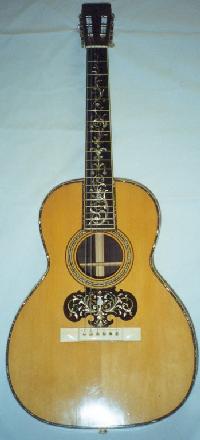
-
Style 42 flat top.
- Abalone inlay around top, soundhole and border around neck tongue.
- Ivory binding on top and back.
- Ivory bridge.
- Pearl tuner buttons.
- Snowflake pattern fingerboard inlays at 5/7/9 frets.
- Snowflake pattern fingerboard inlays at 5/7/9/12/15 frets.
- Ebony bridge replaces ivory.
- Celluloid binding replaces ivory.
- Bound neck with varied patern fingerboard inlays.
- OM-42 made with 14 fret neck, 25.4" scale, solid unbound peghead, nickle plated banjo tuners. Front of the peghead is plain (no inlay and no Martin logo).
- Tortoise pickguard.
Collectibility Rating: Pre-WWII OOO-42: A+, OO-42: A-, O-42: B.
Rosewood back and sides, fancy inlay, fancy backstripe, ebony fingerboard. 0-42 and 00-42 were always 12 fret models until discontinued in 1942.
1858 Style 42 Introduction specs:
1898 Style 42 specs:
1901 Style 42 specs:
1918 Style 42 specs:
1930 Martin Style 42 guitar specs:
1932 Style 42 specs:
Style 42 discontinued in (last 000-42 made in 1943). D-42 introduced in 1986.
Back to Table of Contents
Style 41 flat top.
Collectibility Rating: Brazilian rosewood D-41 size: B+. Indian rosewood
D-41 size: D-.
-
Rosewood back and sides, inlaid bridge pins, abalone inlay along the top,
and sound hole only. Fancy backstripe, ebony
fingerboard, hexagonal abalone fingerboard markers from 3rd to 15th fret,
triple bound peghead, vertical pearl logo, volute on neck.
First listed in 1969 in D-size
only.
- Larger hexagonal fingerboard inlays from 3rd to 15th fret.
- 31 Brazilian rosewood D-41 models made in 1969 (starting with #252014). All others Indian rosewood and not collectible.
- Smaller hexagonal fingerboard inlays from 1st to 17th fret.
- Scalloped bracing.
1969 Style 41 Introduction specs:
1987 Style 41 specs:
Back to Table of Contents
Style 40 flat top.
Collectibility Rating: B (would be higher but most models were
made in Hawaiian style).
-
Rosewood back and sides, abalone (pearl) inlay around top edge and soundhole
(but not on top around the fingerboard like a style 41,42,45 would have),
inlaid bridge pins. Fancy backstripe of horizontal lines between
two rows of diagonal lines (like style 45). Most style 40 models made
were hawaiian style with flat fingerboard radius, flat flush frets, high
string action, and no bridge saddle compensation. Most popular was
the OO-40H (though they did made 2-40, 0-40, 000-40 and 000-40H models prior to WW2).
Sometimes these are converted to regular "spanish" style
guitar (fingerboard radiused, refretted, neck reset, bridge saddle angled).
Made from the 1860s to 1917, then 1928 to 1941, then 1985 to present.
- German silver tuners with pearl buttons.
- Ivory bound fingerboard and peghead.
- Ivory bridge
- Ivoroid bound top and back.
- Snowflake inlays beginning at 5th fret.
- Unbound fingerboard and peghead.
- Style 40 discontinued.
- Style 40 reintroduced.
- Ebony bridge.
- Most often seen as the Martin 00-40H (hawaiian) with 12 frets clear of the body and a sloted peghead. The 00-40H maintained this configuration until 1941 when it was discontinued.
- Style 40 discontinued. Reintroduced in 1985 with slightly different specs.
1860s Style 40 Introduction specs:
1909 Style 40 specs:
1917 Style 40 specs:
1928 Style 40 reintroduction specs:
1941 Style 40 specs:
Back to Table of Contents
Style 35 flat top.
Collectibility Rating: D-35 1965 to 1969: C-, D-35 1970 to present: D-.
-
Rosewood back and sides, 3-piece back with marquetry between sections,
ebony bridge, bound ebony fingerboard, dot inlays, volute on neck.
First listed in 1965 in D-size only.
- Celluloid tortoise pickguard and body binding.
- Black plastic pickguard and body binding.
- Indian rosewood back and sides.
1965 Style 35 Introduction specs:
1967 Style 35 specs:
1970 to present Style 35 specs
Back to Table of Contents
-
Collectibility Rating: 1934-1944 OOO-28 and D-28 sizes: A, 1945-1965 OOO-28 and
D-28 sizes: B, 1965-1969 OOO-28 and D-28 sizes: C. Smaller body sizes subtract a
full letter grade.
- Ivory Herringbone body binding around top edge.
- Zipper-pattern backstripe.
- Slotted diamond fingerboard inlays. Two inlays at 5th fret, 1 at 7th fret, 2 at 9th fret.
- White celluloid herringbone binding material replaces genuine ivory binding.
- Most sizes braced for steel strings.
- OM-28 introduced with 14 fret neck, pyramid bridge, 25.4" scale length, no pickguard, banjo tuners, inlays at frets 5/7/9, solid peghead with no "Martin" decal. Pickguard added in late 1929.
- 1923 0-28k specs: Curly Koa body, including top. Steel strings, nut adjuster, regular style 28 trimmings with herringbone around top. Pyramid bridge with straight saddle. Suitable for regular playing with nut adjuster removed.
- 1925 0-28k specs: High nut and pyramid bridge with straight saddle
- 1926 0-28k specs: Listed with flush frets (not suitable for spanish style playing).
- 1929 0-28k specs: Raised frets optional, lacquer finish.
- 1930 0-28k specs: Belly bridge, straight saddle.
Rosewood back and sides, volute or "ice cream cone" on back of neck. First listed in 1870s.
1870 Style 28 Introduction specs:
1901 Style 28 specs:
1919 Style 28 specs:
1925 Style 28 specs:
1929 Style 28 specs:
-
Sub-group: Martin O-28K (koa):
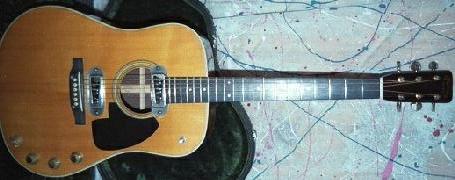
-
1930 Style 28 specs:
- OM-28 has a belly bridge and silkscreened "Martin" peghead logo.
- OM-28 gets a larger pickguard, right angle tuners, and inlays at frets 5/7/9/12/15.
- D-28 introduced with 12 fret neck, white bridge pins with tortoise colored dots (a total of 41 D-28s were made from 1931 to 1933 with a 12 fret neck).
- Inlays from 5th to 15th fret, 2 inlays at 5th fret, 1 at 7th fret, 2 at 9th fret.
- Sunburst shaded top available.
- Tortoise shell pickguard.
- OM-28 discontinued.
- D-28 gets 14 fret neck.
- Heavy bracing replaces scalloped bracing.
- Small graduated dots replaces slotted diamond inlays.
- Large uniform sized dot finger board inlays.
1931 Style 28 specs:
1932 Style 28 specs:
Late 1933 Style 28 specs:
1934 Style 28 specs:
Late 1944 Style 28 specs:
1946 Style 28 specs:
-
1947 Style 28 specs:
- Large graduated sized dot finger board inlays.
- Black/White binding with white grained outer layer replaces herringbone binding (last herringbone was serial# 98223).
- Narrow chainlink backstripe replaces zipper pattern (last zipper back was serial# 99992).
- Grover Rotomatic tuners.
- Outside white binding no longer grained.
- Black plastic pickguard replaces celluloid tortoise pickguard.
- Indian rosewood back and sides replaces Brazilian (last Brazilian rosewood model was serial# 254497).
- Scalloped bracing available HD-28 model.
- Herringbone binding available HD-28 model.
1958 Style 28 specs:
1966 Style 28 specs:
1967 Style 28 specs:
Late 1969 Style 28 specs:
1975 Style 28 specs:
Back to Table of Contents
Style 21 flat top.
Collectibility Rating: 1934-1944 OOO-21: B, 1945-1965 OOO-21 and
D-21 sizes: C, 1965-1969 OOO-21 and D-21 sizes: D. Smaller body sizes subtract a
full letter grade.
-
Rosewood back and sides, style 18 type neck (no volute).
First listed in 1869. 0-21 and 00-21 always has 12 fret neck (except for three
made during the 1930s) until discontinued.
- Ebony fingerboard.
- No fingerboard inlays.
- Herringbone back stripe.
- 5 soundhole rings.
- Herringbone soundhole ring, tortoise outside binding layer.
- Slotted diamond fingerboard inlays. One inlay at 5th fret, 2 at 7th fret, 1 at 9th fret.
- No 000-21 models made fromn 1932 to 1937.
- Inlays from 5th to 15th fret, 2 inlays at 7th and 12th frets.
- Black outside layer body binding.
- Tortoise pickguard.
- Tortoise outside layer body binding.
- Three 00-21G (gut string) made in 1937 & 1938 only.
- 000-21 reintroduced with a 14 fret neck. The 00-21 stayed 12 fret until 1994 when it was a retired model. The 0-21 also stayed 12 fret until 1948 when it was discontinued.
- 0-21 rosewood fingerboard replaces ebony.
- Heavy bracing replaces scalloped bracing.
- Small graduated dots replaces slotted diamond inlays.
- Larger uniform sized fingerboard dots.
- Black/White inlay replaces herringbone around soundhole.
- Narrow checked backstripe replaces herringbone.
- Larger graduate sized fingerboard dots.
- 00-21, 000-21: Rosewood fingerboard replaces ebony.
- 0-21 discontinued.
- 000-21 discontinued.
- One 000-21 made special order.
- Black plastic pickguard replaces celluloid tortoise pickguard.
- First Indian rosewood Martin guitars (#254498).
1869 Style 21 Introduction specs:
1890s Style 21 specs:
1901 Style 21 specs:
1932 Style 21 specs:
1936 Style 21 specs:
1937 Style 21 specs:
1938 Style 21 specs:
1941 Style 21 specs:
Late 1944 Style 21 specs:
1946 Style 21 specs:
1947 Style 21 specs:
1948 Style 21 specs:
1955 Style 21 specs:
1965 Style 21 specs:
1967 Style 21 specs:
1969 Style 21 specs:
Style 21 still available today.
Back to Table of Contents
Style 18 flat top.
Collectibility Rating: 1934-1944 OOO-18 and D-18 sizes: B, 1945-1965 OOO-18 and
D-18 sizes: C, 1965-1969 OOO-18 and D-18 sizes: D. Smaller body sizes subtract a
full letter grade.
-
Originally introduced with rosewood back and sides, the Style 18 since
1917 has Mahogony back and sides, no volute neck, black bridge pins.
First listed in 1857.
- Ebony fingerboard.
- No fingerboard inlays.
- Rosewood back and sides.
- 0-18, 00-18 introduced, unbound ebony fingerboard, rectangle bridge.
- Small dot fingerboard markers at 5th, 7th and 9th frets.
- Soundhole inlay of nine alternating black and white rings, inbetween two single black rings.
- Black back stripe.
- Mahogany back and sides.
- Rosewood binding on top and back.
- Most style 18 models braced for steel strings.
- 000-18 has 25.4" scale length.
- OM-18 introduced with small pickguard, belly bridge, black bridge pins and black backstripe, 14 fret neck, 25.4" scale (longer than 000-18), no peghead decal, banjo tuners.
- OM-18 has larger pickguard, normal right angle tuners, decal peghead logo.
- 00-18 now uses a belly bridge (0-18 still has a rectangle bridge).
- Tortoise pickguard.
- 5-ply top binding with black plastic outer layer.
- Single ply black plastic back binding.
- Small graduated dot fingerboard inlays from the 5th fret to the 15th fret. The 5th fret inlay is the largest (1/4"), with the 7th fret being slightly smaller, and the 9th, 12th and 15th being all the same size (smaller still). The size of the dots goes from .25" to .20 to .15" in diameter at the 9th thru 15th frets.
- D-18 Introduced with a 12 fret neck, ebony fingerboard, black bridge pins (a total of 29 D-18s were made from 1932 to 1933 with a 12 fret neck).
- 000-18 replaced by the 0M-18 (only in 1932 & 1933), and 000-18 not available.
- 0-18 now uses a belly bridge.
- OM-18 discontinued in late 1933.
- 000-18 reintroduced (replaces OM-18) with 14 frets clear of the body, 24.5" scale.
- D-18 now has a 14 fret neck.
- Shaded sunburst top optional.
- 0-18, 00-18, 000-18: some with rosewood fingerboard.
- 0-18, 00-18, 000-18: most with rosewood fingerboard (still some with ebony).
- Tortoise outer body binding used on some Style 18 models. Body size 000-18 and smaller used tortoise first, with D-18 models getting tortoise outer body binding around 1938. But either black or tortoise can be seen in 1936-1938 on Style 18 models.
- 0-18, OO-18, 000-18: rosewood fingerboard standard (D-18 still uses ebony).
- Heavy bracing replaces scalloped bracing.
- Some models have rosewood back binding instead of tortoise celluloid, due to wartime shortages.
- Either Sitka or Adirondack Red spruce top (Sitka is prevelant on D18's).
- Larger uniform sized dot fingerboard inlays replace small graduated dots.
- Sometimes multi-piece Adirondack spruce tops are seen in this year on 000 models.
- Sitka spruce top (darker than the 1945 and prior Adirondack spruce).
- Rosewood fingerboard replaces ebony on D-18.
- Large graduated sized dot fingerboard inlays (larger than the pre-1946 graduated dots) at 5th, 7th, 9th, 12th and 15th frets. Dot sizes start at .30" to .25" to .20" in diameter at the 9th thru 15th frets.
- Body binding changes to black (instead of tortoise).
- Black pickguard (instead of tortoise).
1857 Style 18 Introduction specs:
1898 Style 18 specs:
1902 Style 18 specs:
1917 Style 18 specs:
1918 Style 18 specs:
1923 Style 18 specs:
1924 Style 18 specs:
1930 Style 18 specs:
1931 Style 18 specs:
1932 Style 18 specs:
1933 Style 18 specs:
1934 Style 18 specs:
1935 Martin Style 18 guitar specs:
1936 Martin Style 18 guitar specs:
1940 Style 18 specs:
Late 1944 Style 18 specs:
1945 Style 18 specs:
1946 Style 18 specs:
1947 Style 18 specs:
1966 Martin Style 18 guitar specs:
1967 Martin Style 18 guitar specs:
1996: 0-18, 00-18 discontinued.
Back to Table of Contents
Style 17 flat top.
Collectibility Rating: Pre-1945 OOO-17 and OO-17: C-, 1945-1965 OOO-17 and
OO-17: D. Smaller body sizes subtract a full letter grade.
-
1856 Style 17 specs:
- Rosewood back and sides.
- Rectangle bridge.
- No back binding.
- white back stripe.
- Most with black neck and ice cream cone neck heel.
- ivory tuner buttons.
- Green and white soundhole rope pattern
- No rope style around soundhole.
- X-braced.
- Small dot inlays at 5, 7, 9th frets.
- Mahogany back and sides.
- Spruce top.
- 3 layer top binding.
- rosewood bound back.
- unbound ebony fingerboard.
- small dot fingerboard inlays at 5/7/9 frets.
- rosewood fingerboard and bridge.
- All mahogany construction, including the top.
- Steel string design (Martin's first model to use it).
- 5 layer soundhole ring.
- No body binding, top or back.
- Model maintains its rectangle bridge (belly bridge never used on this style).
- tortoise pickguard optional.
- tortoise pickguard standard.
- black pickguard.
1870's Style 17 specs:
1897 Syle 17 specs:
Style 17 discontinued 1898.
1906 Style 17 reintroduction specs:
1909 Style 17 specs:
Style 17 discontinued 1918.
1922 Style 17 reintroduction specs:
1927 Style 17 specs:
1930 Style 17 specs:
1932 Style 17 specs:
1934 Style 17 specs:
Style 17 discontinued 1961.
1967 Style 17 reintroduction specs:
Style 17 discontinued 1968.
Back to Table of Contents
Style 16 flat top.
Collectibility Rating: D-
Mahogany top, sides and back. Multiple bound top with dark outer binding, unbound back, dot fingerboard inlays, non-gloss finish.
-
1961 Style 16 specs:
- Style first introduced on the 0-16 and 0-16NY models.
- 5-16 model introduced, discontinued in 1963.
- D-size style 16 introduced. Single bound top and back, koa, mohagany, ash or walnut offered (at different times).
- 000-16 and 000C-16 (cutaway) model introduced.
1962 Style 16 specs:
1986 Style 16 specs:
1990 Style 16 specs:
Back to Table of Contents
Style 15 flat top.
Collectibility Rating: D--
Mahogany top, back and sides. No binding used, rosewood fingerboard and bridge, semi-gloss finish, rectangle bridge used for all production. Very similar to the Style 17, except the finish was less glossy.
-
1935 Style 15 specs:
- Introduced with two early examples having birch and maple bodies.
- Mahogany body standard.
- Model re-introduced.
- Last 0-15 model made.
- Style 15 only available in tenor format.
1940 Style 15 specs:
Style 15 discontinued 1944.
1948 Style 15 reintroduction specs:
1961 Style 15 specs:
Style 15 discontinued 1963. Reintroduced in 1997 with different specs.
Back to Table of Contents
A 1932 Martin C-1 Archtop with round sound hole.
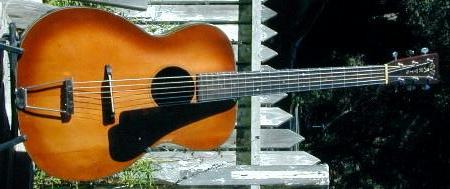
Style C-1 arch top.
Collectibility Rating: D--
Arch top body size is equivalent to the flat top 000 body size, 15" wide across the top, carved spruce top, back is not carved but is arched by bracing, mahogany back and sides, style 18 flat top trim, trapeze tail piece, rosewood fingerboard, nickel plated parts, sunburst top finish.
-
1931 Style C-1 specs:
- Vertical pearl "Martin" peghead logo on early models.
- Round sound hole.
- f-holes introduced instead of round sound hole. Made either way this year.
- Decal style peghead logo (vertical pearl logo dropped).
- Round sound hole completely dropped in favor of f-holes.
- White body binding instead of tortoise.
- Style C-1 discontinued.
1932 Style C-1 specs:
1933 Style C-1 specs:
1935 Style C-1 specs:
1942 Style C-1 specs:
Back to Table of Contents
Style C-2 arch top.
Collectibility Rating: D-
Arch top body size is equivalent to the flat top 000 body size, 15" wide across the top, carved sruce top, back is not carved but is arched by bracing, rosewood back and sides, unbound elevated tortoise pickguard, style 28 type multiple bound top and back with white outer layer, zipper zigzag backstripe, trapeze tail piece, rosewood fingerboard, vertical "Martin" peghead logo, nickel plated parts, sunburst top finish.
The C-series archtops were long scale until mid-1934, same as the 000 models. Sometimes a C model is converted from an archtop to a 000 style flat top. A conversion of a short scale C-2 (mid-1934 and later) won't exactly be a 000 either. The neck must be shortened to get the shallower angle required for a flat top. This amounts to about 1/3 of a fret, so the guitar ends up having a 13 2/3 fret neck. This puts the bridge position a little lower on the top, closer to the OM bridge position (but not exactly the same). The other feature on the C models that is different from a 000 is the back arch and the back braces. The archtops have more arch in the back and taller #3 and #4 back braces. Note the 1939 and later C-2 models have no abalone, the neck inlays are pearloid.
-
1931 Martin C-2 guitar introduction specs:
- Round sound hole.
- Unbound fingerboard.
- Slotted diamond fingerboard inlays.
- f-holes introduced instead of round sound hole. Made either way this year.
- Round sound hole completely dropped in favor of f-holes.
- Bound fingerboard.
- Scale length shortened (much like the 000 models).
- Fingerboard inlays change to hexagonal pearloid inlays at frets 3,5,7,9,12,15.
1932 Style C-2 specs:
1933 Style C-2 specs:
1935 Style C-2 specs:
1939 Style C-2 specs:
1942 Martin Style C-2 guitar discontinued.
Back to Table of Contents
Style C-3 arch top.
Collectibility Rating: D
Arch top body size is equivalent to the flat top 000 body size, 15" wide across the top, carved spruce top, back is not carved but is arched by bracing, rosewood back and sides, 5-ply top binding with pearloid outer layer, elevated tortoise pickguard with b/w binding, backstripe of two horizontal lines surrounded by two rows of diag lines (like a Style 45), bound ebony fingferboard, style 45 fingerboard snowflake inlays, trapeze tail piece, vertical "Martin" peghead logo, bound peghead, gold plated parts, sunburst top finish.
The C-series archtops were long scale until mid-1934, same as the 000 models. Sometimes a C model is converted from an archtop to a 000 style flat top. A conversion of a short scale C-2 (mid-1934 and later) won't exactly be a 000 either. The neck must be shortened to get the shallower angle required for a flat top. This amounts to about 1/3 of a fret, so the guitar ends up having a 13 2/3 fret neck. This puts the bridge position a little lower on the top, closer to the OM bridge position (but not exactly the same). The other feature on the C models that is different from a 000 is the back arch and the back braces. The archtops have more arch in the back and taller #3 and #4 back braces. Note the 1939 and later C-2 models have no abalone, the neck inlays are pearloid.
-
1931 Martin C-3 guitar introduction specs:
- Round sound hole.
- f-holes introduced instead of round sound hole. Made either way this year.
- Round sound hole completely dropped in favor of f-holes.
1932 Style C-3 specs:
1933 Style C-3 specs:
1934 Martin Style C-3 discontinued.
Back to Table of Contents
Style F-1 arch top.
Collectibility Rating: D--
Arch top body, 16" wide across the top, similar trim to the C-1 arch top, mahogany back and sides, f-holes, sunburst top finish.
Introduced in 1940 and discontinued in 1942.
Style F-2 arch top.
Collectibility Rating: D-
Arch top body, 16" wide across the top, similar trim to the C-2 arch top, rosewood back and sides, f-holes, sunburst top finish.
Introduced in 1940 and discontinued in 1942.
Style R-17 arch top.
Collectibility Rating: D---
Arch top body like a 00 size flat top, 12 frets clear of the body, 14 1/8" wide across the top, top not carved but arched with braces, mahogany top, back not carved but arched by braces, 3 piece f-holes, sunburst top finish.
Introduced in 1934 and discontinued in 1942.
Style R-18 arch top.
Collectibility Rating: D--
Arch top body like a 00 size flat top, 12 frets clear of the body, 14 1/8" wide across the top, arched spruce top, back not carved but arched by braces, 4 ply top binding with black outer layer, sunburst top finish.
-
1932 Style R-18 introduction specs:
- Inside body stamped as 00-18S (instead of R-18).
- Round sound hole.
- Top is not carved, but arched with braces.
- Stamped R-18 on inside of body.
- 3 piece f-holes starting in late 1933.
- Top is now carved.
- 1 piece f-holes.
- Style R-18 discontinued.
1933 Style R-18 specs:
1937 Style R-18 specs:
1942 Style R-18 specs:
Back to Table of Contents
Style F-7 arch top.
Collectibility Rating: D
Arch top body 16" wide across the top, carved spruce top, back not carved by arched by braces, rosewood back and sides, f-holes, style 45 backstripe, bound ebony fingerboard, 2 white lines inlaid down length of fingerboard at the edges, hexagonal fingerboard inlays on 6 frets (sometimes pearl, sometimes ivoroid), vertical "Martin" pearl peghead logo, nickel plated parts, sunburst top finish.
Introduced in 1935, discontinued in 1942.
Style F-9 arch top.
Collectibility Rating: D+
Arch top body 16" wide across the top, carved spruce top, back not carved by arched by braces, rosewood back and sides, f-holes, style 45 backstripe, bound ebony fingerboard, 2 white/black/while lines inlaid down length of fingerboard at the edges, abalone hexagonal fingerboard inlays on 8 frets (a few make with pearloid), vertical "Martin" pearl peghead logo, gold plated parts, sunburst top finish.
Introduced in 1935, discontinued in 1942.
Martin Ukuleles.
-
Ukuleles were in highest production from 1916 to the 1930's, though
still manufactured in quantity until 1965. Production quantities during
some periods were as great as Martin guitars. Martin ukes are considered to
be the best for craftsmenship and sound. The Koa
wood models are more collectible than mahagony models. The fancier style 5
models are worth more than plainer styles 0 to 3. All sizes are
collectible.
The first Martin ukes, built in 1916, have serial numbers ranging from one to less than 200. Ukes made after 1916 do not have serial numbers and must be dated by specification changes.
Ukes have the Martin stamp on the back of the peghead until 1935. Peghead decals do not appear in catalog photos till after WWII.
Total Body Body Scale Style Length Length Width Length Soprano (std) 21" 9 7/16" 6 3/8" 13 5/8" Concert 23 1/4" 11" 7 5/8" 14 3/4" Tenor 26 1/4" 12 1/16" 8 15/16" 17" Baritone 30 11/16" 14" 10" 20 1/8"Martin ukuleles produced in greatest numbers in the smallest soprano size, but concert and tenor sizes were available circa 1922. Concert and tenor models were available in all the following styles, with the exception of Style 0, which was produced only as a soprano. Custom order ukuleles, while rare, were available upon request, and may have combined features from various styles.
Martin Style 0 Uke specs:
The most basic of Martin ukes. Mahogany body with
no body binding and nothing fancy. Discontinued in the 1970s.
- Introduced in 1922.
- Mahogany body.
- No body binding.
- 12 fret rosewood fingerboard with bar frets.
- C.F.Martin & Co. on back of headstock.
- Small dot inlays.
- Rosewood friction pegs.
- 1927: Ebony nut and nickel plated pegs
- 1932: Decal logo on front of headstock
- 1934: T frets
- 1970s: discontinued. Recently the S-O (made in Mexico) has been introduced.
Martin Style 1 Uke specs:
Introduced in 1918, the first Martin uke model made. Discontinued
in 1965.
- Introduced in 1918,
- First 200 or so ukes serial numbered, thereafter without.
- Mahogany body.
- Rosewood outer body binding with inner black/white.
- 12 fret rosewood fingerboard with bar frets.
- Earliest examples with boxwood bridge saddle and nut.
- C.F.Martin & Co. on back of headstock.
- Small dot inlays.
- Rosewood friction pegs.
- 1920: Koa wood 1K available
- 1927: Patent pegs
- 1932: Decal logo on front of headstock
- 1934: T frets, dark plastic binding
- 1942: Style 1K last listed
- 1965: Style 1 last listed and discontinued.
Martin Style 2 Uke specs:
Martin style 2 uke model made first in 1918, discontinued in 1965.
- Introduced in 1918.
- Mahogany body.
- Triple bound top binding with ivorioid outer binding.
- Single bound back.
- 12 fret rosewood fingerboard with bar frets.
- C.F.Martin & Co. on back of headstock.
- Small dot inlays.
- 1920: Koa wood 2K available
- 1923: Nickel patent pegs
- 1932: Decal logo on front of headstock
- 1933: Style 2K last listed
- 1934: T frets
- 1965: Style 2 last listed
Martin Style 3 and Style 3k Uke specs:
Martin style 3 uke model made first in 1918, discontinued in the 1970s.
- Introduced in 1918.
- Mahogany body.
- 7 layer top binding.
- 3 layer back binding.
- 5 layer soundhole ring.
- Celluloid ornament on top, behind bridge (known as the "parend").
- 17 fret ebony fingerboard extents to the soundhole.
- Bar frets.
- Small pearl paired-diamond inlays at fret 5, 7, 9.
- 3 lines inlaid down center of fingerboard.
- Nut of 3 ply plastic.
- C.F.Martin & Co. on back of headstock.
- Kite-shaped celluloid peghead ornament.
- Friction pegs.
- 1920: Koa wood 3K available
- 1923: No peghead ornament, nickel plated pegs:
- 1930: One piece ivory nut
- 1932: Decal logo on front of headstock
- 1934: T frets
- 1940: No celluloid top ornament (parend)
- 1940: Dot inlays replace pearl diamond inlays and inlaid lines
- 1941: last Style 3K
Martin Style 5 and Style 5k Uke specs:
Though discontined in 1942, the Style 5 has been reintroduced recently.
- Introduced in 1922.
- Koa body.
- Ivoroid bound top and back with abalone trim.
- Abalone pearl and black/white wood around soundhole.
- Ivoroid bound ebony fingerboard.
- 17 fret ebony fingerboard extents to the soundhole.
- Bar frets.
- Varied snowflake pearl inlays.
- Koa peghead veneer with pearl-inlaid flowerpot.
- Patent pegs.
- 1934: T frets
- 1940: Style 5 mahogony body (same trim as 5K) introduced.
- 1940: Style 5K discontinued
- 1942: Style 5 mahogony body discontinued.
- Note: It has been alleged that Martin used Abalone additionally on the SIDES of style 5k ukes during 1926 and 1927. No such uke has yet been seen.
Back to Table of Contents
Copyright all rights reserved.
